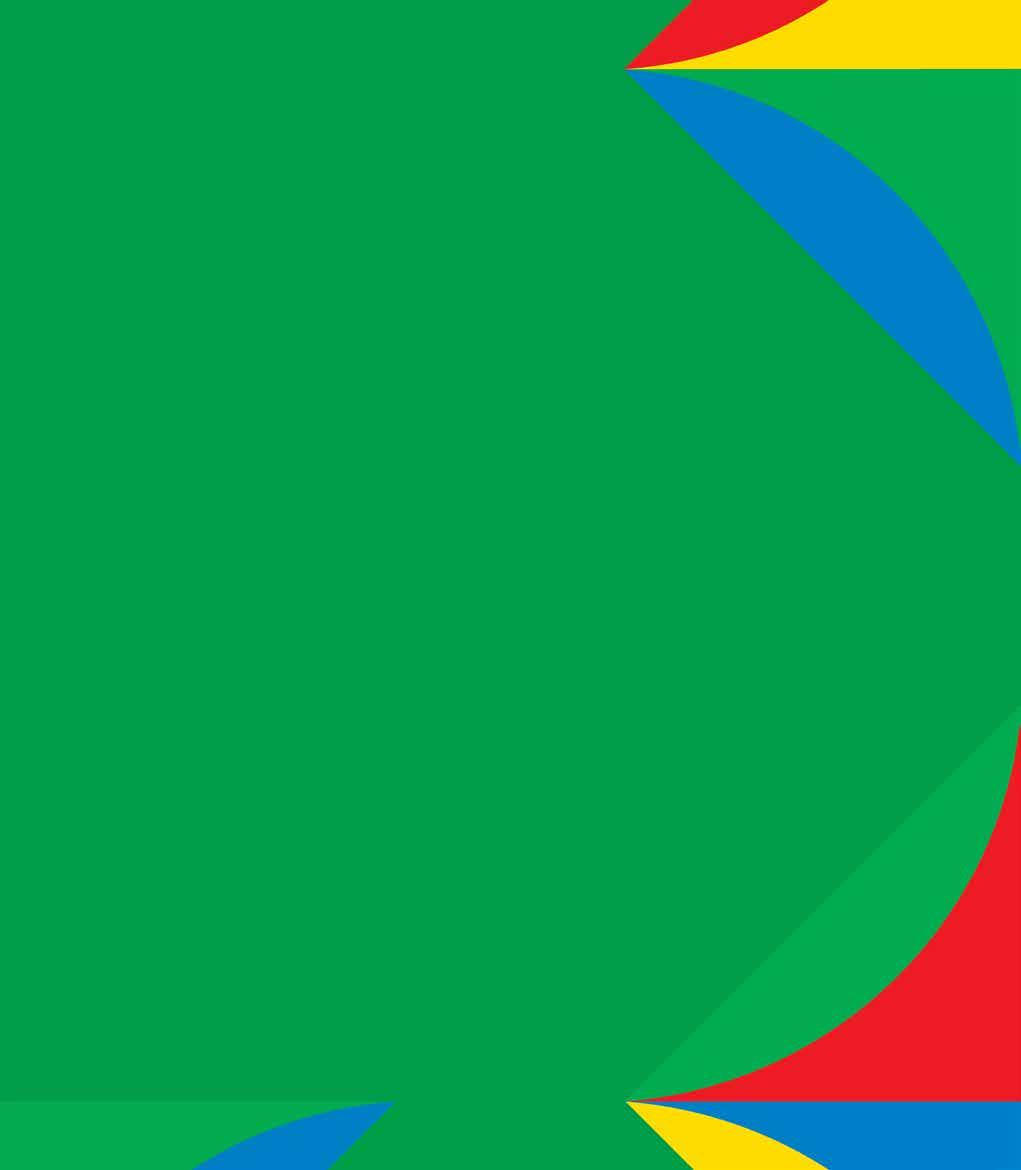ABRE ALAS 18
Aline Brant Ana Bia Silva
Ana Mohallem Andy Villela
Anna Menezes Alexandre Paes
Ariel Ferreira Augusto Braz
Benedito Ferreira Camila Proto
Celo Clara Luz Cyshimi
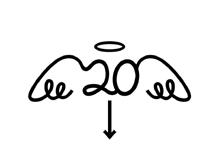
Daiane Lucio Dariane Martiól
Denis Moreira Érica Storer
Genietta Varsi Luiz Sisinno
Mapô Marina Lattuca
Mônica Coster Newton Santanna
Rafael Vilarouca Raphael Medeiros
Rebeca Miguel Rose Afefé
Vulcanica Pokaropa
Yanaki Herrera
Salve companheires,
Chegou a hora de colher os frutos, se despir dos anseios e vestir as mais vivas fantasias. Pular carnaval como quem atravessou tempestades e rachou os lábios em um inverno gélido. Um velho amigo nos abraça. Mais cascudo, mais maduro, retoma sua faixa, entregue por mãos que pintam a diversidade de um país. É a chegada de tempos mais amenos, quentes, férteis.
O surdo dá o compasso do bloco que segue através dos tempos. Esse ano são 20 de A Gentil Carioca. Quanta vida vivida! Nosso Abre Alas brinca, mais uma vez, na encruzilhada de todes nós. Chegando à maioridade, na sua 18ª edição, nossa tão esperada abertura anual refaz os caminhos e convoca novas faces. Com mais de 500 inscrições, vemos que a arte resiste mais uma vez, atenta, em vários Brasis. Agradecemos a todes inscrites e ao nosso trio mágico, feminino e plural, composto por Bruna Costa, Lia Letícia e Vivian Caccuri, que reuniu forças e construiu o enredo para esse desfile. Com os olhos bem abertos, amarrou em laços sutis o que hoje apresentamos a vocês. No Rio ou em Sampa, tá bonito de ver!
Dear comrades,
The time has come to reap the fruit, cast off our fears, and dress in our most vital costumes. To enjoy the carnival as someone who sailed through storms and cracked their lips in an icy winter. An old friend embraces us. More seasoned, more mature, he puts his sash back on, delivered by hands that colour a country’s diversity. More fertile, warmer, pleasant times have arrived.
The bass drum sets the beat for the parade that struts through time. This year marks the 20th anniversary of A Gentil Carioca. What a life well lived! Our Abre Alas frolics once more at the crossroads of us all. Coming of age with its 18th edition, our longawaited annual opening retraces paths and summons new faces.
With over 500 submissions, we see that art once again resists, sharp and alive, in several Brazils. We would like to thank everyone who signed up and our magical, female and plural trio, composed of Bruna Costa, Lia Letícia and Vivian Caccuri, who joined forces and started off the samba-enredo for this parade. With their eyes wide open, the trio bound together, with subtle threads, what we present to you today. In Rio or Sampa, it’s a sight to be seen!
A Gentil Carioca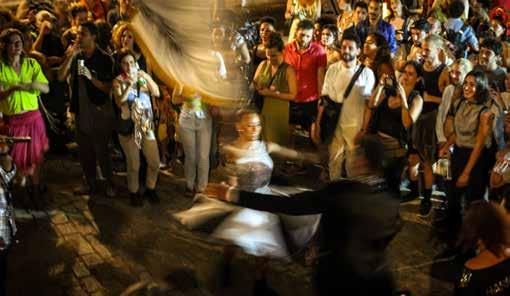
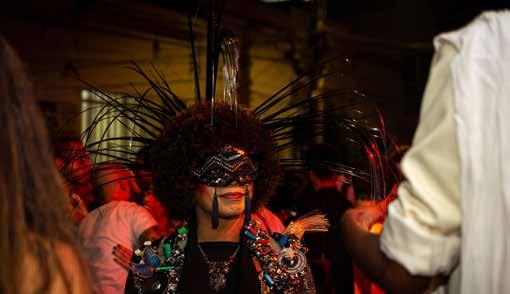
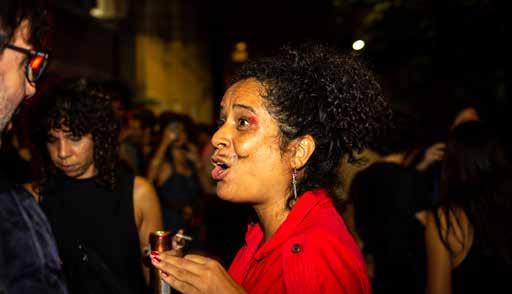

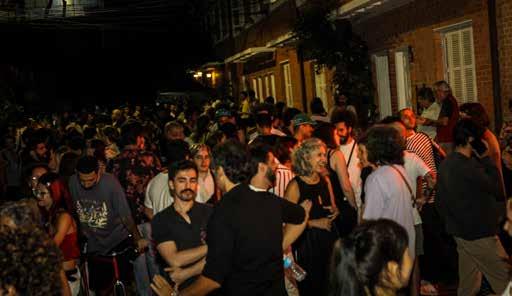
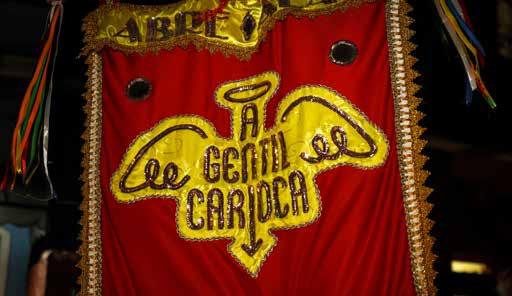
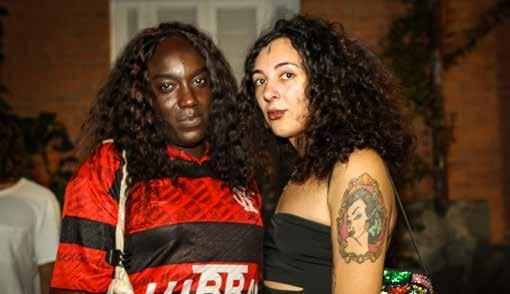
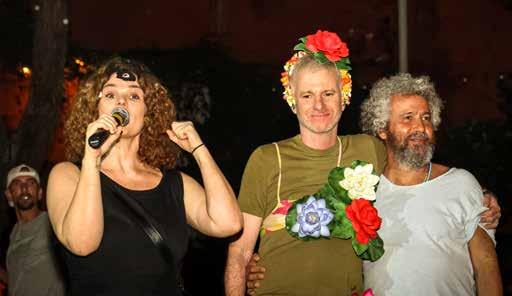
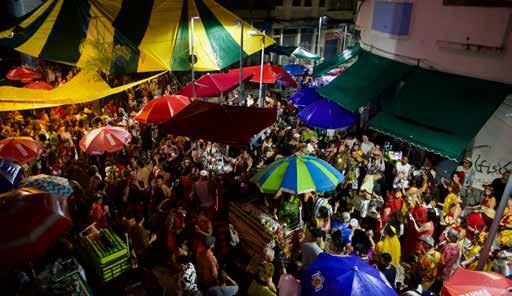


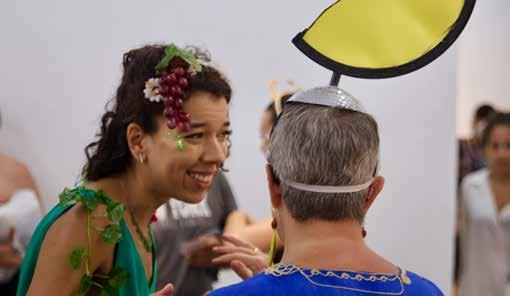

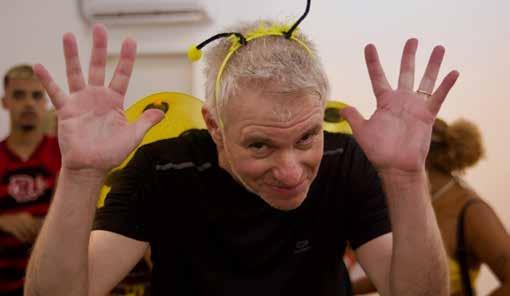
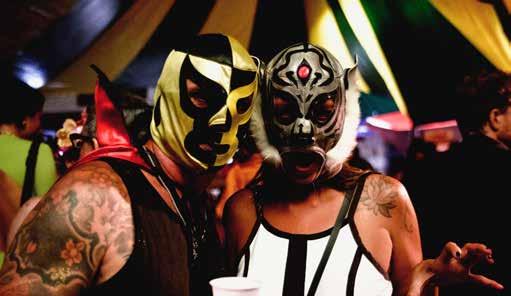
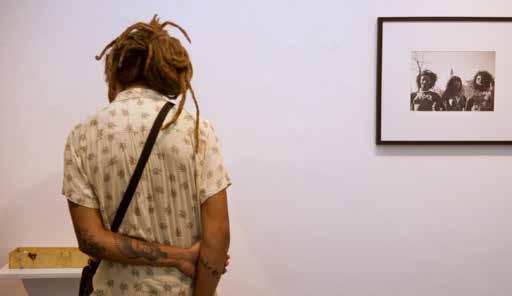
Imageações* atmosféricas
“Enquanto ser vivo, cada animal e cada homem participa, exprime e articula esta vida”.
Emanuele Coccia
Estamos saindo de um longo inverno, de suspensão de direitos, de ataques ao estado democrático e ao patrimônio cultural, de reacionarismo, para a chegada de um verão. O relaxamento do corpo, o anseio pela catarse e a transformação do espaço público em uma grande arena de lazer em 2023, ganham um outro significado e importância: o prazer não é mais escape, é uma condição vital. Sabemos que não é possível saltar do inferno ao céu, do inverno profundo ao auge do verão, mas os tempos recentes trouxeram alguma esperança. Artistas, e estes que participam do Abre Alas 2023, se mantêm alertas. O que vivemos nos últimos anos nos mostra que se tornou quase impossível, para um artista brasileiro, não se tornar vigilante.
Compartilhamos desta atmosfera política, imbuídos, incutidos, inclusos em sistemas que são inseparáveis. Em cada um de nós há algo de todos nós. A seleção foi pensada a partir dessa mistura de vida. Não é sobre neutralizar privilégios, porque não está tudo bem, mas sim evidenciá-los nessa mesma atmosfera, e tentar restabelecer uma devolução.
A mescla não como suspensão das diferenças e identidades, mas de busca por aproximações: diante do que emerge num recorte de tantas inscrições, enxergamos confluências que criam um corpo comum. Memória e aceleracionismos; ecologias, trabalho e capital; cosmologias; e o reencantamento pela arte.
Que a atmosfera proporcionada por estes artistas do Abre Alas 2023 reforce esses bons ventos de retomada.
* sobre Imageações, a partir do pensamento de Denise Ferreira da Silva, ver: https://www.youtube.com/watch?v=8m3TYD5uZjs
Imageações* atmosféricas (Atmospheric imaginactions)
“As a living being, each animal and each man takes part, expresses, and articulates this life.”
Emanuele CocciaWe are coming out of a long winter of suspension of fundamental rights, attacks on the democratic state and cultural heritage, and reactionism, and are moving towards the arrival of summer. The relaxing of the body, the yearning for catharsis, and the transformation of public space into a large leisure arena take on another meaning and importance in 2023: pleasure is no longer an escape, but a vital condition.
We know that it is not possible to leap from hell to heaven, from the deepest winter into the peak of summer, but recent times have brought us some hope. Artists, and those who take part in Abre Alas 2023, remain alert. What we have experienced in the last years shows us that it has become almost impossible for a Brazilian artist not to be vigilant.
We share this political atmosphere, imbued, instilled, included in systems that are inseparable. In each of us there is something of all of us. The selection was developed from this mixture of life. It’s not about neutralizing privileges, because that’s not okay, but about making them apparent in that same atmosphere, and trying to reestablish a devolution.
The mixture is not a suspension of differences and identities, but a search for approximations: faced with what emerges from a selection of so many applications, we see confluences that create a common body. Memory and acceleracionisms; ecologies, labour and capital; cosmologies; and the reenchantment of art.
May the atmosphere made possible by these artists of Abre Alas 2023 reinforce the good winds of recovery.
Bruna Costa, Lia Letícia and Vivian Caccuri* about Imageações (Imaginactions), based on Denise Ferreira da Silva’s thought, see: https://www.youtube.com/watch?v=8m3TYD5uZjs
Aline Brant
A série AUTO-MATA parte da utilização da madeira, da mecânica e do bordado para propor o resgate de memórias coletivas dos povos originários. As obras produzem frames de um filme, trazendo um novo olhar nas “matas invisíveis” dentro de cada um. O passado está representado por bordados que revivem o movimento dos autômatos a partir da interação com o fruidor, trazendo a ideia do presente e de que todos carregam uma carga ancestral que reflete em seu atual momento. Curumins valoriza as memórias das brincadeiras ancestrais que representam um aprendizado constante, a construção de uma identidade e o reconhecimento de uma tradição. Fogo somos todos, a nosso modo, uma força só.
The AUTO-MATA series emerges from the use of wood, mechanics and embroidery to rescue collective memories of original peoples. The works become frames of a film, suggesting a new perspective on the “invisible forests” that exist inside each one. The past is represented by embroideries that revive the movement of the automata from the interaction with the user, bringing the idea of the present and that everyone carries an ancestral load that is reflected in their current moment. Curumins (Kids) values the memories of ancestral games that represent constant learning, the construction of an identity and the recognition of a tradition. Like fire, we are all, in our own way, a single force.

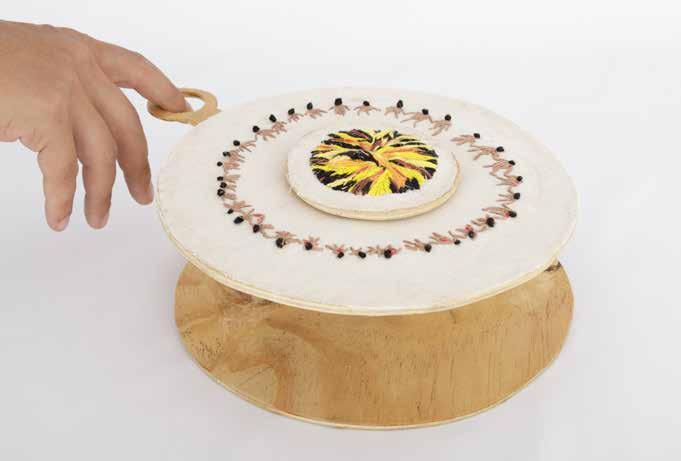
Aline Brant é formada em cursos de fotografia e intervenção em Artes Visuais. Suas obras permeiam aspectos do feminino, subconsciente e natureza, discutindo a dinâmica relação entre as muitas identidades do ser e as infinitas possibilidades de ressignificação da imagem. Atualmente trabalha com foco em arte têxtil, produzindo obras de bordado livre e intervenção têxteis, dando seguimento a sua trajetória poética.
Aline Brant has a degree in Photography and Intervention in the Visual Arts. Aspects of the feminine, the subconscious and nature permeate her works, which discuss the dynamic relationship between the many identities of being and the infinite possibilities of resignifying the image. The current focus of her work is on textile art, with freestyle embroidery and textile intervention pieces, through which she is continuing her poetic trajectory.
Curumins [Kids], 2022 /série Auto-mata [Auto-mata series] / autômatos de madeira e bordado [wooden automatons and embroidery] / 15 x 31 cm [5 7/8 x 12 1/4 in] Fogo [Fire], 2022 / série Auto-mata [Auto-mata series] / autômatos de madeira e bordado / [wooden automatons and embroidery] / 10 x 28 cm [4 x 11 in]Ana Bia Silva
A palavra “estigma” no senso comum refere-se às características que marcam negativamente algo ou alguém, na botânica o termo se refere ao órgão onde o pólen inicia a germinação, que no milho conhecemos como “cabelo”. Me aproprio do termo para falar da exploração capitalista da terra através da mineração e da monocultura, trazendo como símbolo o milho, que é uma das maiores monoculturas do mundo presente em todos os continentes e que segue destruindo a vegetação e arruinando o solo através da erosão e do seu empobrecimento. Enfincado no milho de barro está uma grande “calda” de cobre, que nos lembra da mineração desenfreada que segue a deixar ”estigmas” na terra. O cobre é o metal mais extraído do Peru, lugar originário do milho.
The word “stigma” in popular understanding refers to the characteristics that negatively mark something or someone. In botany, the term refers to the organ where pollen initiates germination, which, in corn, we know as “hair”. I appropriate the term to talk about the capitalist exploitation of land through mining and monoculture, suggesting maize as a symbol, since it is one of the largest monocultures in the world, present on all continents, and which continues to destroy vegetation and ruin soil through erosion and its impoverishment. Stuck in the sculpture made of clay, a large copper “tail” reminds us of the unbridled mining that continues to leave “stigmas” in the earth. Copper is the most extracted metal in Peru, where corn originates.
Pensando a terra, a artista constrói reflexões sobre as relações culturais e exploratórias que os sistemas hegemônicos de poder estabelecem e como se sucedem na relação interdependente da natureza, dos povos e dos outros sistemas de vida que compartilham dessa terra. A artista se apropria de técnicas tradicionais e experimentais e cria relações entre os materiais naturais e industriais onde a experimentação é parte inerente do processo, refletindo sobre conceitos históricos, científicos e afetivos. O seu trabalho desenvolve simbioses possíveis com elementos inerentemente conectados, ascendendo as questões políticas, culturais, sociais e ecológicas.
Thinking about the earth, the artist creates reflections on the cultural and exploitative relationships established by hegemonic systems of power and how they succeed one another in the interdependent relationship of nature, peoples and other systems of life which share this earth. The artist appropriates traditional and experimental techniques and creates relationships between natural and industrial materials. Experimentation is an intrinsic part of the process, reflecting on historical, scientific and affective concepts. Her work develops possible symbioses with inherently connected elements, ascending to political, cultural, social and ecological issues.
 Estigma [Stigma], 2020 / argila, fio de cobre e resina epóxi [clay, copper wire and epoxy resin] / 200 x 6 cm [78 3/4 x 2 3/8 in] / Edição de 10 [Edition of 10]
Estigma [Stigma], 2020 / argila, fio de cobre e resina epóxi [clay, copper wire and epoxy resin] / 200 x 6 cm [78 3/4 x 2 3/8 in] / Edição de 10 [Edition of 10]
Ana Mohallem
AM Stretcher, 2022 / cúpula de acrílico cristal 4mm, caixa de papelão, pastel seco, botão L/D, condutores, organizador de cabos amarelo, fita isolante, solda, pilha A23, suporte para pilha A23, lacre de segurança, cabo de madeira, motor vibratório 3V, suporte de acrílico para luz neon, parafuso de aço inoxidável, porca de aço inoxidável, placa de patrimônio em aço inoxidável. [4mm crystal acrylic dome, cardboard box, dry pastel, L/D button, conductors, yellow cable organizer, insulating tape, solder, A23 battery, A23 battery holder, security seal, wooden handle, 3V vibrating motor, acrylic neon light bracket, stainless steel screw, stainless steel nut, stainless steel heritage plaque] / 19 x 24 x 12,5 cm [7 1/2 x 9 1/2 x 4 7/8 in]
AM Stretcher é uma ferramenta de desenho: um pastel seco acoplado a um motor vibratório autônomo. Nesse caso, a ferramenta já não serve mais para aumentar a destreza de quem a manipula, mas tampouco está a serviço de si mesma: age como um sismógrafo para captar os movimentos da lógica do acaso. O trabalho investiga a tensão entre o propósito prático e a potência poética das ferramentasenquanto objetos, mas também enquanto dispositivos simbólicos - e busca propor caminhos para outros elos com o mundo real, que transbordem o vigente “ser útil”.
AM Stretcher is a drawing tool: a dry pastel coupled to an autonomous vibrating motor. In this case, the tool no longer serves to increase the dexterity of those who manipulate it, but neither is it at its own service: it acts as a seismograph to capture the movements of the logic of chance. The work investigates the tension between the practical purpose and the poetic power of tools - as objects, but also as symbolic devices - and seeks to propose ways for other links with the real world, which overflow the current “being useful”.
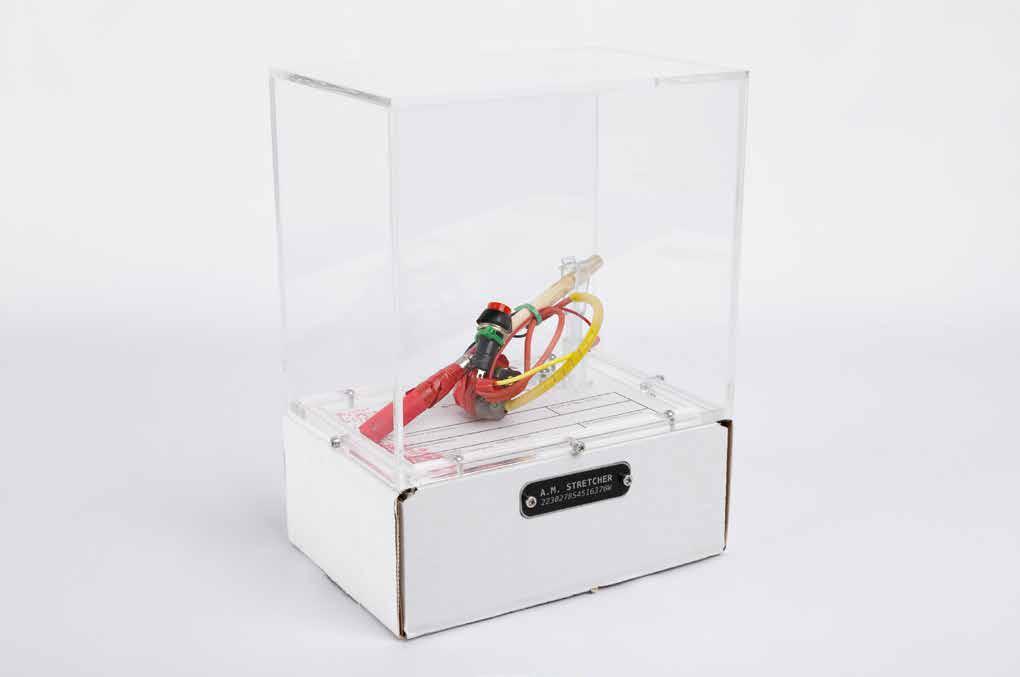
Ana Mohallem nasceu em Itajubá (MG) em 1991. Desde 2009 vive e trabalha em São Paulo (SP). Aos 18 anos descobriu uma condição degenerativa na retina e hoje tem 40% da visão. Esse dado movimenta e nutre os principais eixos de sua pesquisa: a conversão do impedimento em recurso e a construção de ferramentas de natureza poética, ou seja, que priorizam a potência e a possibilidade à finalidade. Em 2022, foi selecionada para o Programa de Exposições do MARP, o SAV, a Bienal Oswaldo Goeldi e o Salão de Arte Contemporânea Luiz Sacilotto.
Ana Mohallem was born in Itajubá (MG) in 1991 and has lived and worked in São Paulo (SP) since 2009. At age 18, a degenerative condition was discovered in her retina and today she has only 40% of her vision. This fact moves and nourishes the main axes of her research: the conversion of this impediment into a resource and the creation of tools of a poetic nature, tools that prioritize potential and possibility over finality. In 2022 she was selected for the MARP Exhibition Programme ‘SAV’, the Oswaldo Goeldi Biennial and the Luiz Sacilotto Contemporary Art Salon.
Andy Villela
Ortigueira é um dos trabalhos que compõem minha mais recente pesquisa sobre perspectivas poéticas dos territórios brasileiros. Ao me debruçar sobre os textos de Milton Santos, compreendi outras perspectivas sobre territorialidade e do próprio espaço geográfico e arquitetônico das cidades. Partindo da premissa que o território se estabelece em duas ou mais formas, socialmente e materialmente, observar tais espaços que nos constituem se dá como uma prática importante para nossa construção, tanto no âmbito pessoal quanto artístico. A teoria da tecnoesfera e da psicoesfera de Milton me auxiliou na produção pictórica da pintura, aplicando a interação de ambos os conceitos e provocando, promovendo e instituindo signos para atender às dinâmicas no caráter processual das obras.
Ortigueira is one of the works that make up my most recent research on poetic perspectives of Brazilian territories. As I studied Milton Santos’ texts, I understood other perspectives on territoriality and the geographic and architectural space of cities. Starting from the premise that the territory is established in two or more ways - socially and materially - observing such spaces that constitute us is an important practice for our construction, both in the personal and artistic scope. Milton’s theory of the technosphere and psychosphere helped me in the pictorial production of painting, applying the interaction of both concepts and provoking, promoting and instituting signs to meet the dynamics in the procedural nature of the works.

Ádito é acesso, entrada, caminho por onde se chega a algum lugar. Com uma camada surrealista, Ádito compõe um cenário em um tempo-espaço múltiplo, reproduzindo essa dinâmica no processo da feitura das pinturas, através da investigação, da liberação do fluxo de ideias do subconsciente que revelam diferentes texturas, formas, cores e signos.
Ádito is access, entrance, path through which one arrives somewhere. With a surrealist layer, Ádito composes a scenario in a multiple time-space, reproducing this dynamic in the process of making paintings through investigation, the release of the flow of ideas from the subconscious that reveals different textures, shapes, colors and signs.
Andy Villela, 1994, nasceu e reside no Rio de Janeiro. A artista utiliza a pintura como eixo dorsal de sua produção. Comunica-se através de símbolos do inconsciente, cedendo espaço para estímulos distintos onde cores, formas e caminhos dão significados às obras através do próprio processo de elaboração. Seu trabalho parte do contato com os materiais e como se desenvolvem em uma linguagem investigativa geralmente atreladas à experimentações pictóricas, propondo questionamentos acerca da racionalidade social e estética pressupostas por normas vigentes. Num resgate emancipatório de criação de uma linguagem própria, sua pintura mescla figurativo e abstrato, afastando a possibilidade de uma leitura literal, tensionado à escala humana e tangível a outras espacialidades, construindo assim, uma narrativa não-linear e que não se atém apenas a pura aleatoriedade, mas permite ir além da imposição de um fazer anestesiado.
Andy Villela (1994) lives in Rio de Janeiro. The artist uses painting as the backbone of her production. She communicates through symbols of the unconscious, giving way to different stimuli with colours, shapes and paths that give meaning to the works through the developmental process itself. Her work starts from the contact with materials and the way they develop into an investigative language generally linked to pictorial experimentation, questioning the social and aesthetic rationality presupposed by current norms. In an emancipatory recovery of the creation of a language of its own, her painting mixes the figurative and the abstract, dismissing the possibility of a literal reading, tensioned to the human scale and tangible to other spatialities, thus building a non-linear narrative that does not simply stick to pure randomness, but allows for a going beyond the imposition of an anesthetized making process.
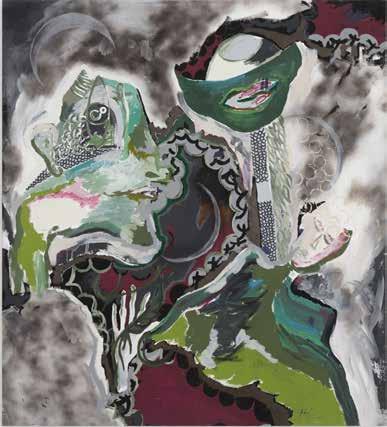
Anna Menezes
As rochas sedimentares são formadas pela junção de detritos, chamados de sedimentos, oriundos da fragmentação de outras rochas, que ocorre na ação dos agentes externos fazendo a transformação do relevo em um processo denominado por intemperismo. Nessa lógica, a obra Corpos Sedimentares retrata, através de fotografias fragmentadas impressas em rochas, diferentes tipos de corpos rompendo com a visão dicotômica entre materialidadeespiritualidade, sensibilidade-consciência, sentir-pensar, natureza-cultura, corpo-espírito. Considera-se que corpos representam identidades, relações históricas em diálogo consigo, com outros, com o mundo, no mundo. Portanto, nessa obra, o corpo funciona como símbolo social, com bagagem histórica e, quando reconhecido pelo indivíduo e os seus, um símbolo ancestral. A escolha do nome Corpos Sedimentares faz conexão com o processo de formação das rochas sedimentares porque os nossos corpos no mundo têm experiências constantes com outros corpos em suas relações sociais. Essas experiências são a junção de desgastes, quebras, sedimentos e detritos que formam esse corpo, que pode ser comparado com a formação da rocha que se quebra e desgasta tornando-se diferentes sedimentos a partir dessas relações naturais. Os espaços da rocha se fundem com os traços do corpo. Há um diálogo entre o corpo da rocha e o corpo humano. Corpo-rocha tornamse um só, mantendo suas particularidades, mas tendo por eixo aquilo que é a própria vida.
Sedimentary rocks are formed by the layering of debris, called sediments, that are products of the fragmentation of other rocks, which occurs in the action of external agents, transforming the relief in a process called weathering. In this sense, the work Corpos Sedimentares (Sedimentary Bodies) portrays, through fragmented photographs printed on rocks, different types of bodies breaking with the dichotomous vision between materialityspirituality, sensitivity-consciousness, feeling-thinking, nature-culture, body-spirit. Bodies are considered to represent identities, historical relationships in dialogue with themselves, with others, with the world, in the world. Therefore, in this work, the body functions as a social symbol, with historical baggage and, when recognized by the individual and his family, an ancestral symbol. The choice of the name Corpos Sedimentares makes a connection with the formation process of sedimentary rocks because our bodies in the world have constant experiences with other bodies in their social relationships. These experiences are the junction of wear, breaks, sediments and debris that form this body, which can be compared with the formation of rock that breaks and wears out, becoming different sediments from these natural relationships. The spaces of the rock merge with the lines of the body. There is a dialogue between the body of the rock and the human body. Body-rock become one, maintaining their particularities, but having life itself as an axis.
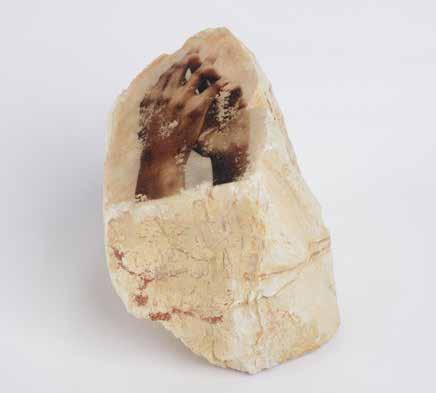
Veredas retrata e propõe uma imersão nos recortes sensíveis do cerrado através da impressão fotográfica de um ipê branco em ladrilho amarelo e projeção de vídeo.
Veredas (Pathways) portrays and proposes an immersion in the sensitive angles of the cerrado through the photographic impression of a white ipê tree on yellow tiles and video projection.

A amplitude do relacionamento de Anna Menezes com as artes visuais perpassa a atividade prática e o desenvolvimento acadêmico. A brasiliense de 26 anos desenvolve um trabalho artístico voltado para a inserção do movimento no objeto estático como maneira de explorar a corporalidade, a psique e as relações sociais dos seres humanos, tendo como base uma experimentação tridimensional de imagens fotográficas fundamentada no suporte enquanto estrutura corporal e conceitual.
The breadth of Anna Menezes’ relationship with the visual arts encompasses practical activity and academic development. The 26 year-old artist from Brasília develops an artistic practice directed towards the insertion of movement in static objects, as a way of exploring the corporality, psyche and social relations of human beings, based on a three-dimensional experimentation with photographic images centred around the medium as a bodily and conceptual structure.
Alexandre Paes
Culturas Improváveis (2021) é uma instalação que apresenta cadernos escolares usados, coletados em sala de aula, semeados e apoiados em assentos e encostos de carteiras escolares igualmente coletados em escolas públicas municipais do Rio de Janeiro. As plantas que brotam nesses cadernos abordam a questão do crescimento e desenvolvimento de formas de vida num terreno fértil, porém extremamente adverso. Assim como as plantas que brotam desses cadernos, a vida que floresce e se desenvolve dentro da escola (também mediada por esses cadernos) é igualmente incerta, difícil e, muitas das vezes, desacreditada.
Culturas Improváveis (Unlikely Cultures), 2021, is an installation that presents used school notebooks collected in the classroom, sown and resting on the seats and backrests of school desks also collected in municipal public schools in Rio de Janeiro. The plants that sprout in these notebooks address the question of the growth and development of life forms in fertile but extremely adverse terrain. Just like the plants that sprout from these notebooks, the life that flourishes and develops inside the school (also mediated by these notebooks) is equally uncertain, difficult and, many times, discredited.
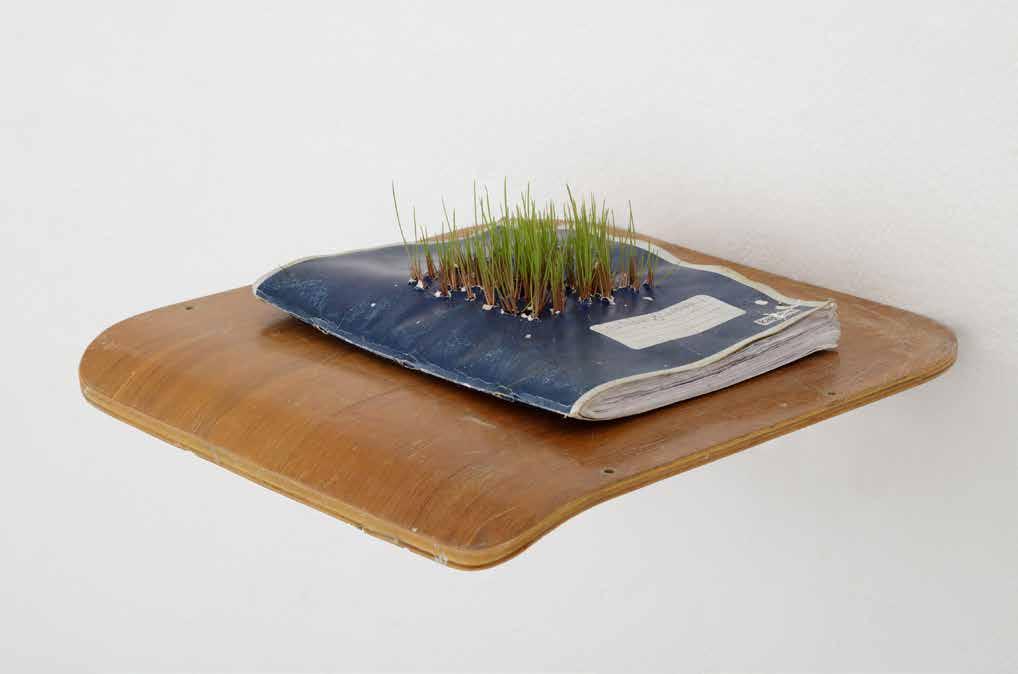
Alexandre Paes (Niterói, 1978), é artista plástico e professor. Mestrando do PPGARTES-UERJ (2022). Cursou pintura na Escola de Artes Visuais do Parque Lage (2004-2008). Desenvolve pesquisa estético-pedagógica sobre o universo escolar e a violência. Sua produção, convertida numa imersão no universo escolar e nas comunidades onde está inserido, busca refletir de maneira poética sobre as trocas e as influências mútuas que se apresentam de forma violenta na escola e no seu entorno.
Alexandre Paes (Niterói, 1978) is a visual artist and teacher, as well as a master student at the PPGARTES programme of UERJ (2022). He studied painting at the Parque Lage School of Visual Arts (2004-2008). His aesthetic-pedagogical research focuses on violence and the school universe. His artistic production converts into an immersion in the school universe and in the communities where it is inserted, and seeks to reflect poetically on the mutual exchanges and influences that are violently present in the school and its surroundings.
Culturas Improváveis [Unlikely Cultures], 2021 / instalação [installation] / dimensões variáveis | 38 x 38 x 10 cm cada [variable dimensions | 15 x 15 x 4 in each]Ariel Ferreira
A câmera persegue um par de pernas cujos passos, ora são arrastados, ora levitam como que magicamente. Parece um desafio da gravidade, e talvez o seja. Na verdade, trata-se das pernas de um catador de material reciclável que puxa um carro pesado, fora de cena, e este exerce uma força de alavanca sobre o homem. O vídeo deve ser exposto necessariamente em uma tv de tubo (adquirida de segunda mão) apoiada diretamente sobre o chão. Uma cópia de O Leviano pertence ao acervo do Museu de Arte da Pampulha (MG).
The camera follows a pair of legs whose steps often drag and other times levitate as if by magic. It seems like a challenge - defying gravity, and maybe it is. In fact, these are the legs of a recyclable material collector pulling a heavy car, out of frame, and this exerts a leverage force on him. The video must necessarily be shown on a tube TV (acquired second-hand) resting directly on the floor. A copy of O Leviano (The Flimsy One) belongs to the collection of the Museu de Arte da Pampulha (MG).
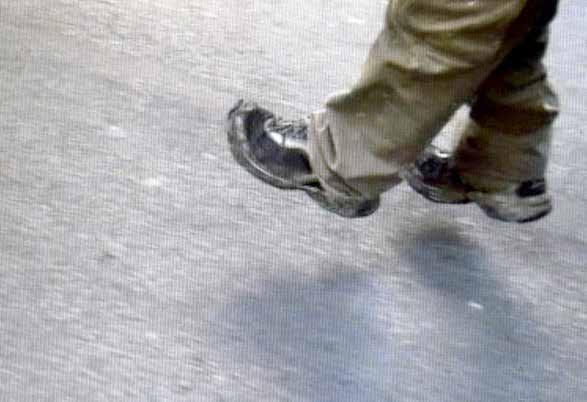
Nesta série, fotografias aéreas de minas e suas catástrofes são apropriadas da internet. As impressões, em sais de prata, são parcialmente riscadas e raspadas nas áreas das imagens que representavam montanhas com vegetação, revelando e salientando as formas aparentemente abstratas da terra devastada. Ao riscar o papel fotográfico, o artista, como os mineiros ou garimpeiros, extrai sua obra por escavação, arrancando material. A série possui a ambiguidade de ser a estetização do horror e a perda de suas dimensões, e, ao mesmo tempo, um protesto contra a mineração em larga escala. Frequentemente os Antipostais de Minas Gerais trazem mensagens escritas com ponta seca de prata sobre base de guache branco.
In this series, aerial photographs of mines and their catastrophes are appropriated from the internet. Silver salt impressions are partially scratched in the areas of the images in which mountains used to be vegetated, revealing and highlighting the apparently abstract forms of the devastated land. By scratching the photographic paper, the artist, like a miner or prospector, extracts his work by excavation, extracting material. The series has the ambiguity of being the aestheticization of horror and the loss of its dimensions, and, at the same time, a protest against large-scale mining. Antipostais de Minas Gerais (Anti-postcards of Minas Gerais) often contain messages written with a silver dry point on a white gouache base.
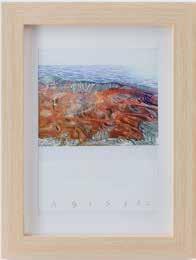
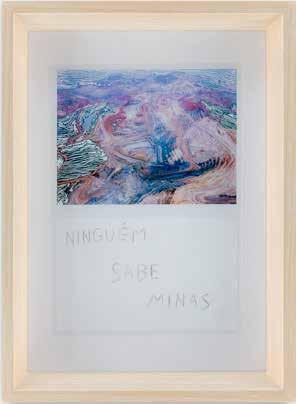
Ariel Ferreira nasceu em Montes Claros (MG). Cresceu em cidades do interior e subúrbio, se tornou adulto no hipercentro de Belo Horizonte. O artista vê a cidade (seu chão e de onde coleta matéria e imagens) não como oposta à paisagem natural, mas como sua extensão, ou uma segunda natureza sobreposta. Faz uso de variados formatos em que a poesia envolvida é tão importante quanto a técnica, o material utilizado e a beleza formal. Seu trabalho mostra que deslocando o ponto de vista a delicadeza é uma força.
Ariel Ferreira was born in Montes Claros (MG). He grew up in cities in the countryside and in suburbs, and moved to downtown Belo Horizonte as an adult. The artist sees the city (his stomping ground, where he collects material and images) not in opposition to the natural landscape, but as its extension, or as a superimposed second nature. He makes use of various formats in which the poetry involved is as important as the technique, the material used and the formal beauty. His work shows that, by shifting your point of view, frailty can be a strength.
Augusto Braz
PUTARIA; TRABALHO; RISCO; DESEJO: quatro eixos de uma pesquisa vivencial em andamento desde 2017, que se dá na fricção entre arte e trabalho sexual. A disposição das palavras indica uma continuidade inesgotável, tentativa de dar conta do intangível, das relações estabelecidas nesse processo. Indícios de uma trajetória pessoal materializada em letras de aço. Narrativa incompleta de uma observação de si e de outres. Desdobramento de um exercício de pensar com o corpo. Epítome compartilha o desafio de refletir criticamente sobre as relações possíveis entre dois universos, para além dos estereótipos exaustivamente (re)afirmados pela cultura dominante.
WHORING; WORK; RISK; DESIRE: four axes of an experiential research in progress since 2017, which takes place in the friction between art and sex work. The arrangement of words indicates an inexhaustible continuity, an attempt to account for the intangible and the relationships established in this process. Indications of a personal trajectory materialized in steel letters. An incomplete narrative of an observation of oneself and of others. The unfolding of an exercise of thinking with the body. Epítome shares the challenge of critically reflecting on the possible relationships between two universes, beyond the stereotypes exhaustively (re)affirmed by the dominant culture.
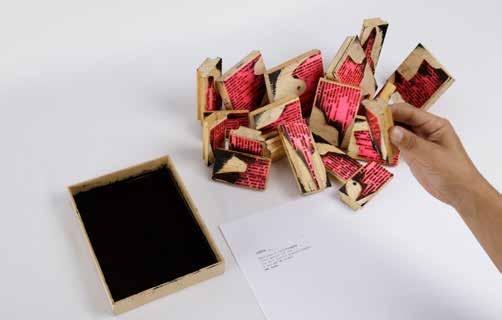
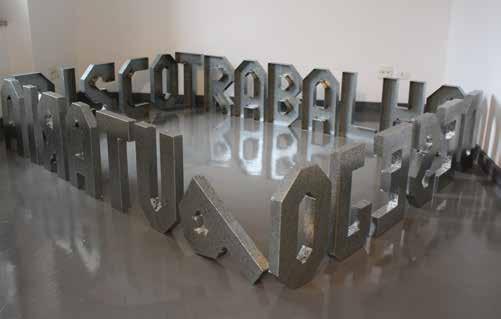
Série com 20 poemas-carimbos, criados a partir de grifos feitos em apostilas de treinamento para bancários recém-admitidos em uma instituição financeira de grande porte. Por meio da ocultação de trechos e apropriação de outros, mantendo as palavras na mesma ordem e flexão, constroemse novos sentidos, almejando expor a essência dissimulada do discurso, ou (re)inventá-la, revelando assim a violência contida no texto original. Este é um trabalho sobre trabalho. Um estudo dos discursos institucionais e a possibilidade de ler as entrelinhas, de distorcê-los poeticamente. É uma reflexão acerca de uma trajetória pessoal e simultaneamente da estrutura das relações de trabalho, lucro, poder, e da regulação dos corpos e comportamentos nesses contextos. Retomar o gesto de carimbar é uma tentativa de incorporar a linguagem cotidiana dessa vivência, sua característica repetitiva, e simultaneamente atribuir aos poemas outras possibilidades de circulação e atravessamentos.
Series with 20 stamp-poems, created from markings made in training handouts for recently hired bank employees at a large financial institution. By hiding excerpts and appropriating others, keeping the words in the same order and inflection, new meanings are constructed, aiming to expose the hidden essence of the discourse, or (re)invent it, thus revealing the violence contained in the original text. This is work about work. A study of institutional discourses and the possibility of reading between the lines, of poetically distorting them. It is a reflection about a personal trajectory and, simultaneously, the structure of labor relations, profit, power, and the regulation of bodies and behaviors in these contexts. Repurposing the gesture of stamping is an attempt to incorporate the everyday language of this experience, its repetitive characteristic, and at the same time to attribute to the poems other possibilities of circulation and crossings.
Bacharel em Artes Visuais pela UERJ e mestrando no PPGCA - UFF. Dedica-se atualmente a investigar relações possíveis entre arte e trabalho sexual. A instalação sonora Confessionário (da série Artista de Programa), exposta no Centro Municipal de Arte Hélio Oiticica em 2019/20, foi construída a partir das narrativas de vivências pessoais no universo da prostituição. Em 2022, participou da Residência Artística FAAP, em São Paulo. Suas pesquisas abrangem ainda performatividades de gênero, sexualidade e desejo; representações de corpos e identidades; e relações de trabalho e poder.
Augusto Braz has a bachelor in Visual Arts from UERJ and is a master student at the PPGCA programme of UFF. The artist is currently dedicated to investigating possible relationships between art and sex work. The sound installation Confessionário (Confessional) from the Artista de Programa (Programme Artist) series was exhibited at Centro Municipal de Arte Hélio Oiticica in 2019/20, and was created from narratives of personal experiences in the universe of prostitution. He participated in the FAAP Artistic Residency programme in São Paulo in 2022. His research also covers the performativities of gender, sexuality and desire; representations of bodies and identities; and labour and power relations.
Benedito Ferreira
Colecionar papéis de carta era o passatempo de muitas crianças entre as décadas de 1980 e 1990. O hábito envolvia também adquirir envelopes coloridos e conferir a resistência dos saquinhos plásticos das pastas. Escrever nos papéis era algo fora de cogitação: quanto mais intactos, mais valiosos eram. Em Arquivo Morto os objetos desejam passar por um processo de “desarquivamento” ao forjarem uma existência textual própria através de frases, rabiscos e adesivos que especulam um interlocutor contemporâneo.
Collecting stationery was a hobby for many children in the 1980s and 1990s. The habit also involved buying coloured envelopes and checking the resistance of the plastic bags in the folders. Writing on the papers was out of the question: the more intact they were, the more valuable they became. In Arquivo Morto (Dead Document), it seems that the objects wish to undergo a process of “unarchiving”, by forging their own textual existence through phrases, scribbles and stickers that speculate a contemporary interlocutor.
Em 2014, Benedito Ferreira recebeu um convite para acompanhar e filmar uma das maiores cavalgadas do Brasil, que saía de Goiânia com destino a Aruanã, município localizado na região noroeste de Goiás e banhado pelo Rio Araguaia. Anos depois, o material produzido compõe Cavalo sem nome, projeto que passa por uma nova montagem sempre que é mostrado. Ao final do período de exibição, os arquivos originais e mesmo a versão apresentada são irrecuperavelmente deletados do único HD.
Benedito Ferreira é artista visual. Sua pesquisa artística está centrada na poética dos arquivos e apagamentos dos limites entre “documento” e “ficção”. Nos últimos anos, colaborou com instituições como MAC Goiás, Círculo de Artes Plásticas de Coimbra, Art Space BLECH for Contemporary Art, Center for Contemporary Art Tbilisi e Czong Institute for Contemporary Art. Seu trabalho integra o acervo do Museu da Imagem e do Som de Goiás, Netherlands Institute for Sound and Vision e Itaú Cultural. Doutorando em Artes na Universidade do Estado do Rio de Janeiro (UERJ).
Benedito Ferreira is a visual artist. His artistic research is centred on the poetics of archives and the erasure of the boundaries between ‘document’ and ‘fiction’. In recent years, he has collaborated with institutions such as MAC Goiás, Círculo de Artes Plásticas de Coimbra, Art Space BLECH for Contemporary Art, Centre for Contemporary Art Tbilisi, and Czong Institute for Contemporary Art. His work is part of the collection of the Museu da Imagem e do Som de Goiás, the Netherlands Institute for Sound and Vision, and Itaú Cultural. He is a PhD student in Arts at the Universidade Federal do Rio de Janeiro (UERJ).
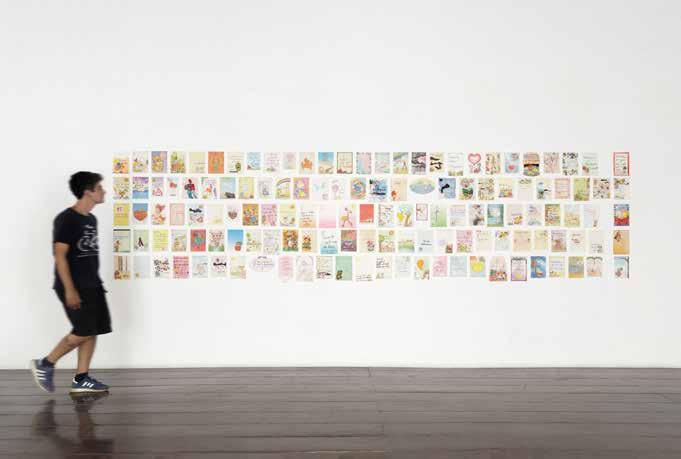
In 2014, Benedito Ferreira received an invitation to witness and film one of the biggest horse marches in Brazil, which left Goiânia for Aruanã, a municipality located in the northwest region of Goiás, through which the Araguaia River flows. Years later, the material produced creates Cavalo sem nome (Nameless Horse), a project which is newly edited every time it is shown. At the end of the exhibition period, the original files and even the presented version are irrecoverably deleted from its only external hard drive.
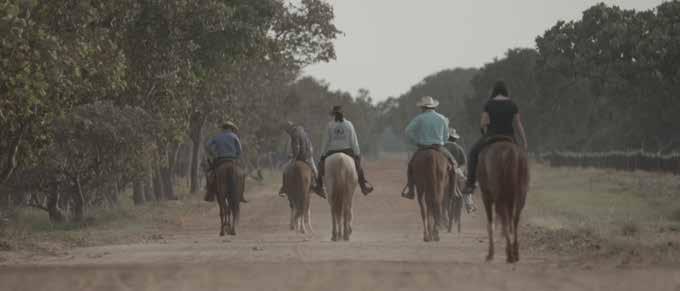
Camila Proto
O Sibilo da Duna no. 1 [The Sibyl of the Dune no. 1], 2022 / série Notações para Paisagens Futuras ou Relevos Gritantes [Notations for Future Landscapes or Striking Reliefs series] / gravura em alto relevo, papel algodão, caixa de som [embossing, cotton paper, sound box] / 80 x 55 cm [31 1/2 x 21 5/8 in]
O Sibilo da Duna no. 2 [The Sibyl of the Dune no. 2], 2022 / série Notações para Paisagens Futuras ou Relevos Gritantes [Notations for Future Landscapes or Striking Reliefs series] / gravura em alto relevo, papel algodão, caixa de som [embossing, cotton paper, sound box] / 80 x 55 cm [31 1/2 x 21 5/8 in]
As obras O Sibilo da Duna no. 1 e O Sibilo da Duna no. 2 fazem parte da série de gravuras em alto relevo intitulada Notações para Paisagens Futuras ou Relevos Gritantes. Nesta série, partituras visuais são arranjadas através da transposição de imagens de satélite para o espaço da pauta: as alturas dos relevos se transformam em alturas melódicas, e torna-se possível ouvir o relevo e suas variações. Gravadas em alto relevo no papel algodão, as formas saltam aos olhos, quase que gritando, em um jogo entre a materialidade e a escuta. Acompanha a partitura uma faixa de áudio que especula tais sons traduzidos; no caso, o sibilar das dunas quando de encontro às rajadas de vento no deserto.
The pieces O Sibilo da Duna no. 1 (The Sibyl of the Dune no. 1) and O Sibilo da Duna no. 2 (The Sibyl of the Dune no. 2) are part of the series of relief engravings entitled Notações para Paisagens Futuras ou Relevos Gritantes (Notations for Future Landscapes or Striking Reliefs). In this series, musical scores are arranged by transposing satellite images to their spaces: the heights of the reliefs are transformed into melodic heights, so it becomes possible to hear their variations. Engraved in high relief on cotton paper, the forms reach out to the eyes in a quasi-scream, creating a game between materiality and listening. The musical score is accompanied by an audio track that speculates on these translated sounds; in this case, the hissing of the dunes when they meet the gusts of wind in the desert.
Camila Proto é artista e pesquisadora. Sua poética adentra o universo fabulatório e especulativo para estimular uma outra escuta do mundo. Dentre suas atividades dos últimos anos, destaca-se: a participação no 4° Prêmio de Arte Contemporânea da Aliança Francesa (2020), indicação ao XIII Prêmio Açorianos de Artes Plásticas (2020), na categoria “Artista em Início de Carreira”, e a exposição individual na Galeria Refresco (2021). Não é representada por nenhuma galeria nem possui obras em coleções.
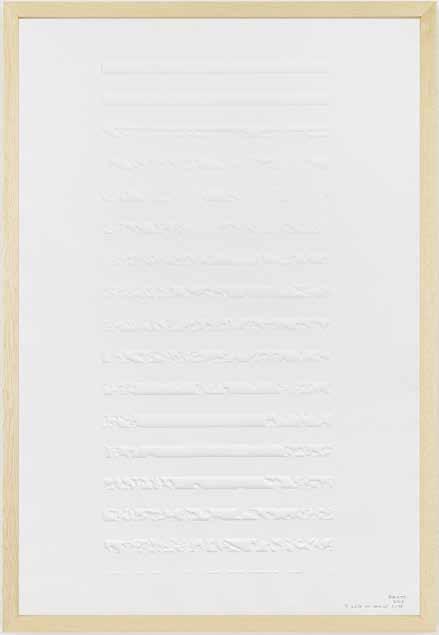
Camila Proto is an artist and researcher. Her poetics enters the fabulatory and speculative universe to stimulate a different listening of the world. Her activities in recent years include her participation in the 4th Contemporary Art Award of Alliance Française (2020); a nomination for the XIII Açorianos Visual Arts Award in the category ‘Artist at the Start of their Career’ (2020); and a solo exhibition at Galeria Refresco (2021). She is not represented by any gallery, nor does she have works in collections.

Celo
Uma cidade artificial assim como todos os sabores de torcida.
O sabor artificial que só dá vazão nesse amontoado de caos carioca. Desde a violência pop Caveirão aos embalos de Zeca e toda a rapaziada de um RJ na tendência.

A city as artificial as all of the Torcida flavours. A taste that only makes sense in this heap of carioca chaos. From the violence of Caveirão pop to Zeca’s partying and the trendiness of Rio de Janeiro’s youth.
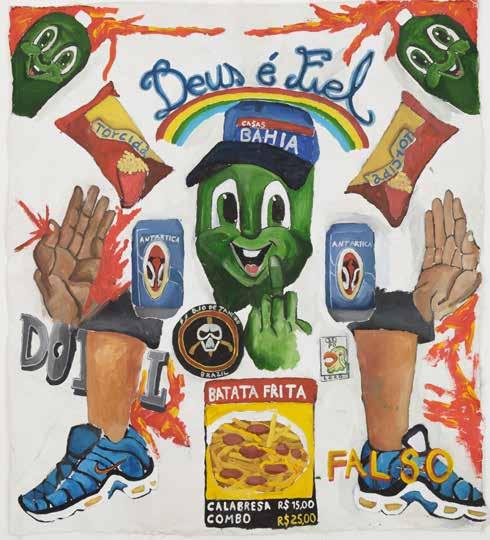
Esculacho sintetiza como é viver nessa cidade carioca, da contradição festiva à pura ousadia de se manter sobrevivente nesse caos e carnaval.
Esculacho sums up how it is to live in the city of Rio de Janeiro, from its festive contradictions to the sheer audacity of survival in chaos and carnival.
Me chamo Celo, sou artista visual autodidata, 27 anos, cria da favela do Pereirão em Laranjeiras (RJ). Como artista, meu principal objetivo é ilustrar as diversas facetas dessa cidade, seu eterno clima de festa que esconde toda sua contradição e condição de cidade violenta, carnavalesca, conservadora, caótica, preconceituosa, hipócrita e estranhamente bela. Recentemente participei da exposição Brasil Delivery no Engenho de Dentro (RJ). Tenho também diversas obras em coleções particulares por São Paulo e Rio de Janeiro. Apresento, em 2022, minha primeira individual em São Paulo, a exposição Gororobas, na Galeria Belizário.
My name is Celo, I’m a self-taught visual artist, 27 years old, and born in the Pereirão favela in Laranjeiras (Rio de Janeiro). As an artist, my main objective is to illustrate the different facets of this city, its eternal party atmosphere that covers up all its contradictions, and its condition of being a violent, carnivalesque, conservative, chaotic, prejudiced, hypocritical, and strangely beautiful city. I recently participated in the Brasil Delivery exhibition at Engenho de Dentro (RJ). Several of my works are in private collections in São Paulo and Rio de Janeiro. In 2022 I presented my first solo show in São Paulo, titled Gororobas, at Galeria Belizário.
Clara Luz
A série Paisagem em desvio, de 2022, é composta de um conjunto de pinturas onde eu busquei, através do volume e da cor, criar paisagens que não se limitassem ao meramente figurativo. Se a tinta sobre o suporte pictorial é, afinal, um conjunto de manchas, volumes e linhas, a paisagem na qual acredito só poderia retratar a mancha, o volume e a linha. Minhas pinturas, embora remetam à paisagem, se referem, sobretudo, a elas mesmas. Para pintar as peças preferi o látex acrílico com corante líquido, não só para valorizar estes materiais, mas porque posso controlar as cores ao prepará-las. Trata-se de ser íntima da cor, pois é a cor o desvio da paisagem, o lugar, aquilo que a pintura informa.
The series Paisagem em desvio (Drifting Landscape), from 2022, is composed of a set of paintings where I sought, through volume and colour, to create landscapes that were not merely figurative. If paint on a pictorial support is, after all, a set of stains, volumes and lines, the landscape which I believe in can only portray the stain, the volume and the line. My paintings, although they refer to the landscape, refer, above all, to themselves. To paint the pieces, I chose acrylic latex with liquid dye, not only to enhance these materials, but because I can control the colours when preparing them. It is about being intimate with colour, because colour is the deviation from the landscape, the place, that which the painting informs.
Clara Luz (Bauru, 2000) vai à capital em 2019 cursar Artes Visuais na ECA-USP e se aprimora no campo da pintura. De 2020 a 2022 passa pelo 16º e 17º Salão Nacional de Arte Contemporânea de Guarulhos, 28° e 29° Programa Nascente USP. Seu trabalho explora a linguagem própria da pintura, em que manchas e volumes justapostos reproduzem imagens de sua memória. A criação e o controle de cores é procedimento primordial às obras, a partir da tinta látex acrílica junto ao corante líquido.
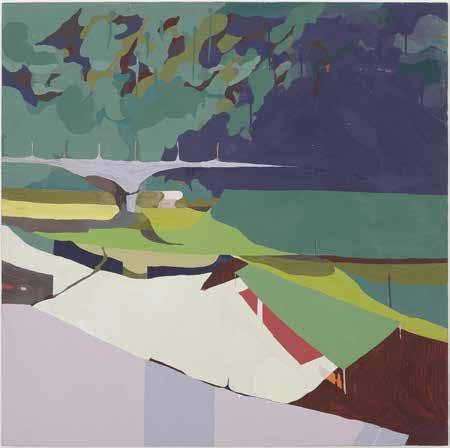
Clara Luz (Bauru, 2000) moved to the capital in 2019 to study Visual Arts at ECA-USP and trained in the field of painting. From 2020 to 2022 she presented her works at the 16th and 17th National Salon of Contemporary Art in Guarulhos, and in the 28th and 29th Nascente USP Programme. Her work explores the language of painting itself, in which juxtaposed spots and volumes reproduce images from her memory. The creation and control of colours is a primordial procedure for the works, in which acrylic latex paint is combined with liquid dye.
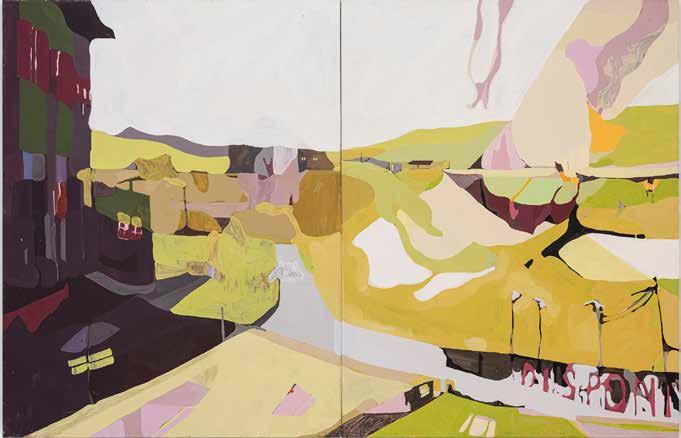
A obra gira em torno de três associações da unha no senso comum: vulgar, sujo e exagero. Tais associações são postas de forma negativa e demonstram um pré-julgamento muitas vezes baseado em questões de gênero, raça e classe, em que muitos defendem a ideia de uma beleza pura, limpa e padronizada. Através de uma instalação transdisciplinar, Cyshimi cria um conflito entre tais ideias pejorativas e as possibilidades de uma unha livre a partir de imagens de unhas esculturais. A artista subverte as tradicionais francesinhas com as frases “Somewhere you belong (Em algum lugar você pertence)”, “Be your teenage dream (Seja o seu sonho adolescente)” e “Reimagining the self (Reimaginando o Eu)”. O título Francesinha Reversa faz referência a mais usada técnica de francesinhas em alongamentos de unhas, ao mesmo tempo em que alude à subversão e contraposição de elementos da obra. Ao longo de sua pesquisa, as unhas representam uma nova visão de mundo, uma nova possibilidade de ser, e a partir dessa nova possibilidade, há uma ruptura de ideias hegemônicas de beleza e de estilo de vida. Suas esculturas de unha são, ao mesmo tempo, reais e surreais - são sobre corpo, identidade e sobre se reimaginar.
The piece revolves around three associations of nails in popular culture: they are either vulgar, dirty or an exaggeration. Such associations are posed negatively and demonstrate a pre-judgement often based on gender, race and class biases, where many hold the idea of a pure, clean and standardized beauty. Through a transdisciplinary installation, Cyshimi creates a conflict between such pejorative ideas and suggests new possibilities for free nails, based on images of sculptural nails. The artist subverts the traditional French nail-do with the phrases “Somewhere you belong”, “Be your teenage dream” and “Reimagining the self”. The title Reverse French Nails makes reference to the most used French-do technique in nail lengthening, while also alluding to the subversion and counterposition of elements in the work. Throughout her research, nails represent a new worldview, a new possibility of being, and from this new possibility, there is a rupture of hegemonic ideas in beauty and lifestyle. Her nail sculptures are at the same time real and surreal - they are about body, identity and about reimagining oneself.
Indumentária da performance Roupa de Treino I e Roupa de Treino II. Essa obra expõe a representação de unhas de treino em um elemento vestível, representado pelo vestido de gala - que representa luxo e opulência - e através dos rituais e processos das primeiras construções de alongamento de unha na tal fase de “treinamento” realizado pela artista. Percebemos uma inversão e deslocamento de sentido, quando colocamos esses dois elementos em jogo: a formalidade e a ostentação do vestido de gala e o lugar em que o treino de manicure é colocado no imaginário do senso comum, como algo a ser escondido e oculto até que o resultado do alongamento seja impecável.
Clothing from the performance Roupa de Treino I and Roupa de Treino II (Training Clothes I and Training Clothes II). This work exposes the representation of training nails in a wearable element, a gala dress - the embodiment of luxury and opulence - and through the rituals and processes of the first nail lengthening constructions in such a “training” phase performed by the artist. We perceive an inversion and displacement of meaning when we put these two elements into play: the formality and ostentation of the gala dress and the place in which manicure training is located in the popular imagination, as something to be hidden and concealed until its results are impeccable.
Roupa de Treino I [Training Clothes I], 2020 / tecido sublimado e unhas em acrílico [sublimated fabric and acrylic nails] / 150 x 50 x 3 cm [59 x 19 3/4


Reverse French Nails (Francesinha Reversa), 2022 / instalação | unhas postiças, acrílico e tecido [installation | fake nails, acrylic and fabric] / 230 x 230 cm [90 1/2 x 90 1/2 in]
Artiste Transdisciplinar, brasileire de ascendência chinesa e taiwanesa. Sua pesquisa permeia questões de ancestralidade, identidade, corpo e beleza através de performance, instalação, arte digital e esculturas de unhas. Para Cyshimi, unhas são Esculturas Performáticas, termo cunhado pela artista que afirma que suas unhas não são apenas um objeto estático, mas uma escultura que molda a performatividade dos corpos. Elas são um símbolo de resistência, empoderamento e identidade. Cyshimi vê cada unha como um mundo novo, construído por formas, cores e texturas que, quando em conjunto, atravessam quem as usa e quem as vê. Esteve em instituições como CCSP, Parque Lage e Instituto Adelina. Mencionade em plataformas como Instagram, Dazed Beauty e Metal Magazine.
Cyshimi is a Brazilian transdisciplinary artist of Chinese and Taiwanese descent. The artist’s research is permeated by questions of ancestry, identity, body, and beauty through performance, installation, digital art and fingernail sculptures. For Cyshimi, fingernails are Performing Sculptures, a term coined by the artist that affirms that her nails are not just static objects, but sculptures that shape the performativity of bodies. They are a symbol of resistance, empowerment and identity. Cyshimi sees each fingernail as a new world, composed of shapes, colours and textures that, taken together, influence those who wear them and who see them. The artist attended institutions such as CCSP, Parque Lage and Instituto Adelina. Cyshimi is mentioned on platforms such as Instagram, Dazed Beauty, and Metal Magazine.
Daiane Lucio
Tem sombra no corpo, esse lugar é um cenário. Um cenário que muda enquanto mudo também - de posição, de cara, de roupa, de energia. Sonhei acordada com a carta do “pendurado”. E só decidi pintar. Aquelas imagens que vem na cabeça quando você está indo ou saindo do sono. É engraçado que a mensagem vem sempre depois da expressão. Deixo a imagem me dar o recado. Essa é a cena de agora. E um agora que já é também passado enquanto falo aqui. Aqui do sofá de uma casa que não é minha, de uma cidade que é só uma das moradas, de um lugar que nunca é constante, onde não sei muito bem onde tô. E tudo que passou parece flash de um sonho. Parece que a vida é assim quando a gente lembra. Quem sabe eu vou lembrar disso quando passar. Saindo aos poucos dos 33 e trocando de pele. Pele com marca na testa e ânimo pro que é real. A travessia.
There is a shadow on the body, that place is a set. A set that changes as I change too - of position, of face, of clothes, of energy. I daydreamed about the “hanging” card. And I just decided to paint - the images that come into your head when you are falling asleep or waking up. It’s funny that the message always comes after the expression. I let the image give me the message. This is the current set. A now that is also already in the past as I speak here. Here, on the sofa of a house that is not mine, of a city that is only one of the addresses of a place that is never constant, where I don’t really know where I am. And everything that has passed seems like a flash of a dream. It seems that life is like that when we remember. Maybe I’ll remember this when I pass. Gradually leaving 33 and changing skin. Skin with forehead marks and encouragement for what’s real. The crossing.
A partir daqui, celebro todos os meus rituais, conversas, orações, plantas, faxinas e produções de tudo que uma cabeça que quer ser livre pra criar navega, mesmo com as limitações que me enrosquei. Foi aqui que escolhi me criar sozinha e é a partir daqui que eu vou pra além. Só eu sei o que chorei jogada no tapete dessa casa e o corre que fiz pra me manter nessa cidade. Aos meus pais e mães que me acompanham.
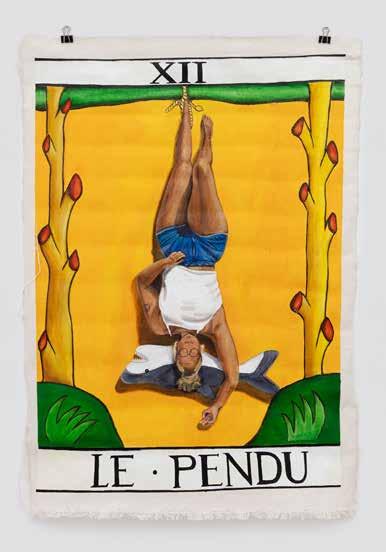
From now on, I celebrate all of my rituals, conversations, prayers, plants, cleaning days and productions of everything that a head that wants to be free to create navigates, even with the limitations that I’ve put on myself. This is where I chose to create myself and this is where I go from here. Only I know how much I cried when I was thrown on the carpet of this house and how hard I worked to keep myself in this city. To my fathers and mothers who accompany me.
Daiane Lucio é nascida em Sorocaba, moradora do centro de São Paulo e viajante pelo Brasil. Desde o início do isolamento social, a expressão através da pintura tem sido ferramenta de conexão com as versões de seu ser desde a infância até as experiências atuais. Na busca pela autonomia como mulher preta num reconhecimento de autoestima e liberdade, hoje vive o deslocamento pelo fio condutor de referências que ligam paisagens, sons e vivências até a cura interna e protagonismo da própria história.
Daiane Lucio was born in Sorocaba, lives in downtown São Paulo, and travels around Brazil. Since the start of social isolation due the Covid-19 epidemic, expression through painting has been the artist’s tool for connecting with versions of her being, from childhood to current experiences. In the search for autonomy as a black woman in recognition of self-esteem and freedom, she nowadays experiences displacement through a guiding thread of references that connect landscapes, sounds and experiences to the internal healing and protagonism of her own story.
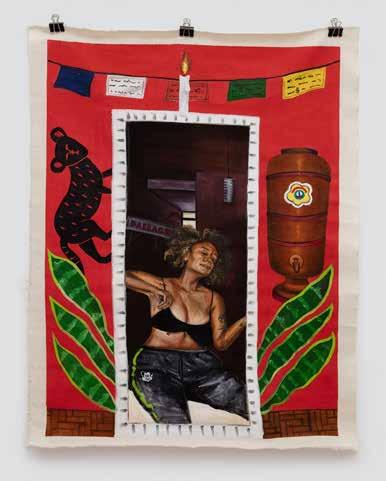
Dariane Martiól
Sem título e Centauras I compõem a série Autorretrato Infamiliar, na qual registro o corpo da minha mãe junto ao meu no espaço doméstico. O projeto teve início em 2021 e seu título faz referência ao Das Unheimlich (O Infamiliar), apontando para uma relação que não é totalmente desconhecida, mas que se apresenta de uma maneira atípica, causando estranhamento. Sou filha de Adair Martiól, que tem 70 anos, é mãe solo e morava sozinha no interior do Paraná até o meu retorno à casa dela em 2020. A minha mãe, que em um primeiro momento era apenas personagem nos meus ensaios, agora cria seus próprios objetos e com orgulho se vê e se diz artista. A arte surge aqui como um jogo de sobrevivência e de subversão por meio do qual apaziguamos os conflitos e movimentamos a vida.
Sem título (Untitled) and Centauras I (Centaurs I) compose the series Autorretrato Infamiliar (Unfamiliar Self-portrait) in which I record my mother’s body next to mine in the domestic space. The project began in 2021 and its title references Das Unheimlich (The Unfamiliar), pointing to a relationship that is not totally unknown, but that presents itself in an atypical way, causing strangeness. I am the daughter of Adair Martiól, who is 70 years old, a single mother who lived alone in the interior of Paraná until my return to her home in 2020. My mother, who at first was only a character in my essays, now creates her own objects and proudly sees herself and calls herself an artist. Art appears here as a game of survival and subversion through which we appease conflicts and move forwards with life.
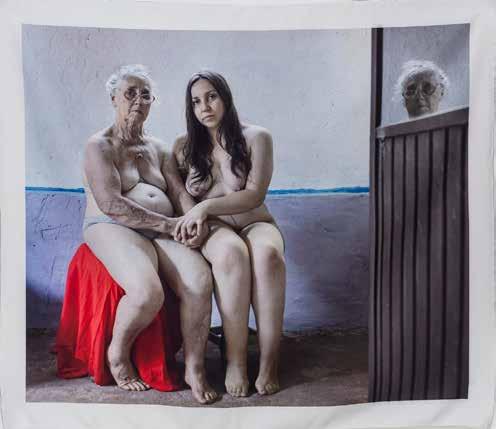
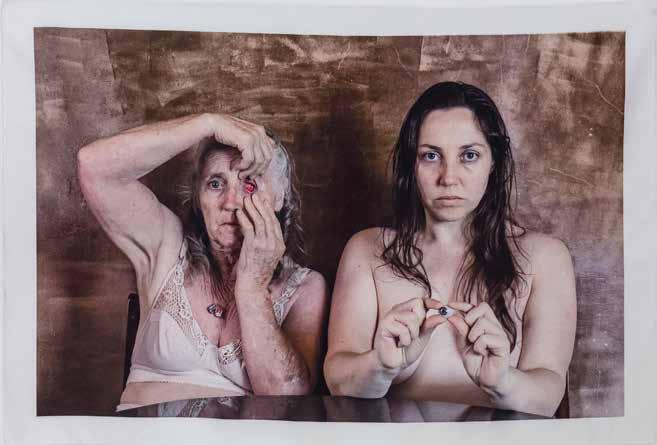
Dariane Martiól (Coronel Vivida (PR), 1988). É artista visual, mestranda no PPGAV/UDESC; bacharela em Pintura e licenciada em Filosofia. Vem participando de diferentes mostras coletivas e em 2021 foi premiada no Festival Photothings de fotografia e no Salão Nacional de Arte Contemporânea de Guarulhos. Em 2022, participou do 32° Programa de Exposições do Centro Cultural de São Paulo. Em seus trabalhos, transita entre diferentes linguagens tematizando o erotismo e seus desdobramentos entre os corpos, gêneros e sexualidades.
Dariane Martiól (Coronel Vivida (PR), 1988) is a visual artist, currently undertaking a master’s degree at PPGAV/UDESC. She holds a bachelor’s degree in Painting and has a licentiate degree in Philosophy. She has participated in different group exhibitions and was awarded at the Photothings Photography Festival and at the Guarulhos National Contemporary Art Salon in 2021. She took part in the 32nd Exhibition Programme of the Centro Cultural São Paulo in 2022. In her work she moves between different languages, thematizing eroticism and its unfolding between bodies, genders and sexualities.
Denis Moreira
Denis Moreira, artista visual, 1986, São Paulo, Brasil. Formado em Artes Visuais pela FMU em 2011. Pesquisador autodidata da cultura africana e afro-brasileira. Realizou uma exposição individual no Salão Angelim, Blumenau (SC) em 2021. Participou das coletivas: 50° Salão de Arte Contemporânea Luiz Sacilotto, em Santo André (SP); 27° Salão de Artes Visuais de Vinhedo, em Vinhedo (SP); Feira ArPa pelo Ateliê 397, em São Paulo (SP); Espaço Fonte, em São Paulo (SP) em 2022; e 46° Salão de Artes de Ribeirão Preto, em São Paulo (SP) e HOA online Leilão Connexion Brasil (USA) em 2021.
Denis Moreira is a visual artist born in São Paulo, Brazil, in 1986. He graduated in Visual Arts from FMU in 2011. He is a self-taught researcher of African and Afro-Brazilian culture. He had a solo exhibition at Salão Angelim, Blumenau (SC) in 2021. He took part in the following group exhibitions: the 50th Luiz Sacilotto Contemporary Art Salon in Santo André (SP); the 27th Vinhedo Visual Arts Salon in Vinhedo (SP); the ArPa Fair at Ateliê 397 in São Paulo (SP); Espaço Fonte in São Paulo (SP) in 2022; the 46th Ribeirão Preto Arts Salon in Ribeirão Preto (SP); and the HOA online Auction Connexion Brasil (USA) in 2021.
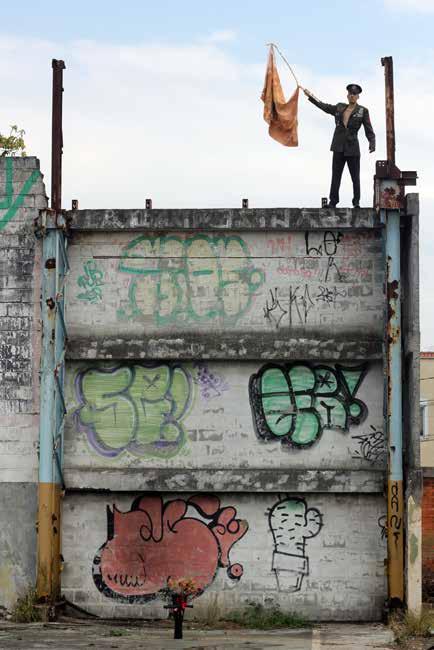
Na série Conquistador, o personagem militar de alta patente se mostra através de suas vestes e feitos pátrios, considerado herói por suas conquistas. As insígnias em seu peito configuram os países conquistados pelo colonialismo europeu. A junção entre a imagem do conquistador com o buquê de rosas secos em volta de cassetetes, remete ao toque, ao cheiro, dialoga com o tempo e a memória. Lógica que acompanha o personagem sem boca e sem olhos, mas que exala ódio. A obra fala também de uma rendição contemporânea, um estado de perda e de total entrega, seja pelo formato da bandeira destituída de vigor, seja pelo isolamento do personagem, um colonialista derrotado.
In the Conquistador series, a high-ranking military character shows himself through his robes and homeland deeds, considered a hero for his conquests. The insignias on his chest configure the countries conquered by European colonialism. The combination of the image of the conqueror and the bouquet of dried roses around the truncheons refers to the touch, the smell, and dialogues with time and memory. An idea that accompanies the character with no mouth and no eyes, but who still exudes hatred. The work also speaks of a contemporary surrender, a state of loss, whether by the shape of the flag devoid of vigor, or by the isolation of the character, a defeated colonialist.
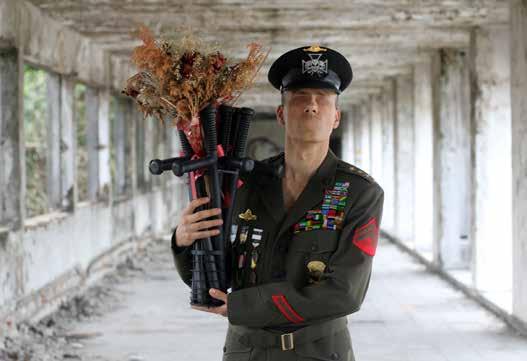
Érica Storer
Em sua sexta edição, a instalação Sonhe Alto, Trabalhe Muito - Vá Longe é composta por uma estação de trabalho suspensa no teto com cordas de sisal. A ficcionalização do trabalho cognitivo, que se aproxima cada vez mais do artista “empreendedor de si mesmo”, paira sobre o constrangimento entre a realidade física e social. Como estratégia, materializamse frases motivacionais que celebram o mito meritocrático do “trabalho vs. conquista”, como um lugar acima a ser conquistado pelo esforço. Todavia, ao pendurá-las no alto, outra condição é incorporada, a fragilidade de sua estrutura e iminência de seu colapso.
In its sixth edition, the installation Sonhe Alto, Trabalhe Muito - Vá Longe (Dream Big Work Hard - Go Far) is composed of a workstation suspended from the ceiling with sisal ropes. The fictionalization of cognitive work, which gets closer and closer to the idea of the artist as “entrepreneur of himself”, hovers over the constraint between physical and social reality. As a strategy, the work materializes motivational phrases that celebrate the meritocratic myth of “work vs. achievement”, as an elevated place that can be conquered by effort. However, by hanging them up high, another condition is incorporatedthe fragility of their structure and the imminence of their collapse.

Rõm-ófice é uma série de instalação domésticas temporárias desenvolvidas em formatos de fotografia e vídeo. A obra é conceitualizada a partir das definições de home office e treadmill desk (esteira - escritório). Estes termos, apropriados da língua inglesa, fazem parte do universo corporativista que cada vez mais invade os limites do espaço privado. A estação de trabalho multifuncional reverbera algo que não é novo: a ânsia pela produtividade e autossuperação. “Tudo é possível!”. A violência da positividade, tangenciada pelo trabalho cognitivo, mantém uma sociedade de superprodução, super desempenho e supercomunicação, na qual não existem motivos suficientes para o descanso.
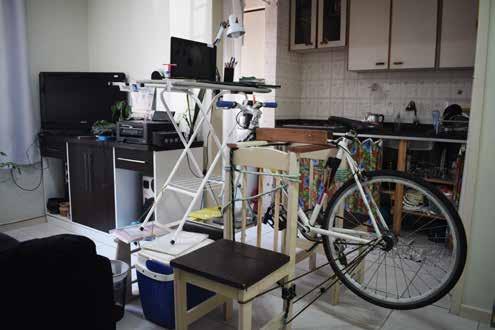
Rõm-ófice (Howm Offis) is a series of temporary home installations developed in photography and video formats. The work is conceptualized based on the definitions of home office and treadmill desk (treadmill - office). These terms, appropriated from the English language, are part of the corporative universe that increasingly invades the limits of private space. The multifunctional workstation reverberates something that is not new: the drive for productivity and self-improvement. “Anything is possible!”. The violence of positivity, touched by cognitive work, maintains a society of overproduction, overperformance, and overcommunication, in which there are not enough reasons for rest.
Érica Storer (Curitiba, 1992) é artista visual. Produz entre os meios da tradição da performance, vídeo e instalação, como uma estratégia de criar ficções e constranger os acordos entre a ética neoliberal e o trabalho contemporâneo. Integrou a Venice International Performance Art Week, em Veneza, Itália (2020). Premiada no 7° EDP das Artes (2020), e no Festival Camelo em Belo Horizonte (2022). Participa da MAJ - SESC Consolação em São Paulo. (2022). Integra os acervos de Luiz Sacilotto em Santo André, SP; Museu de Arte Universitário da UFPR (MUSA) e Museu Paranaense em ambos em Curitiba, PR.
Érica Storer (Curitiba, 1992) is a visual artist. Her artistic production spans the media of the traditions of performance, video and installation, as a strategy for creating fictions and constraining the agreements between neoliberal ethics and contemporary work. She took part in the Venice International Performance Art Week in Venice, Italy (2020). She won awards at the 7th EDP das Artes (2020), and at the Camelo Festival in Belo Horizonte (2022). She participated in MAJ-SESC Consolação in São Paulo (2022). Her work is included in the following collections: Luiz Sacilotto in Santo André, SP; UFPR University Art Museum (MUSA), and the Museu Paranaense, both in Curitiba, PR.
Sonhe Alto Trabalhe Muito - Vá Longe #06 [Dream Big Work Hard - Go Far #06], 2022 / instalação | escritório suspenso [installation, suspended office] / dimensões variáveis [variable dimensions] Rõm-ófice [Howm Offis], 2020 / impressão Fine Art com moldura de alumínio fosco cinza escura [Fine Art print with dark gray matte aluminum frame] / 90,5 x 135,5 cm [35 3/8 x 53 1/8 in] / 1/5 + P.A.Genietta Varsi
Raízes que batem no céu (2) [Roots that reach the sky (2)], 2022 / série de 12 desenhos impressos em risografia [series of 12 drawings printed in risography] / 215 x 215
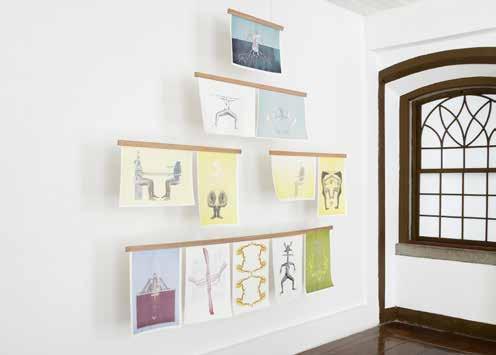
sol rotação atmosfera em fluxo correntes levam, trazem pedaços de corpos giram, modelam, comunicam mensagens que quedam no ar, memória acumulada viaja pelas veias, orifícios hélices sopram vibrações que transformam céu e solo
terra piso com peso força, energia boca, nariz, sopro quente, úmido, seco troca sutil atmosfera dentro, vísceras fora o interno, dentro o externo partículas dispersas cultivação do ar, agricultura do céu
lua horizonte do corpo músculo diafragma tórax e abdômen gás e sólido crer e criar água une dança de pressões
aerar, inflar, desinflar voando, sonhando navegando no tempo, sem tempo histórias que permanecem flutuando forças que unem passado, presente, futuro somos sem limites os poros nos unem
sun rotation atmosphere in flux currents carry, bring pieces of bodies that rotate, shape, communicate messages that stay in the air, accumulated memory travels through veins, orifices propellers blow vibrations that transform sky and soil
earth floor with weight strength, energy mouth, nose, breath hot, wet, dry subtle exchange atmosphere inside, entrails outside inside, inside the outside scattered particles cultivation of air, agriculture of sky
moon horizon body muscle diaphragm thorax and abdomen gas and solid believe and create water unites dance of pressures
airing, inflating, deflating flying, dreaming navigating in time, without time stories that remain floating forces that unite past, present, future we are without limits pores unite us
Pesquisa a maleabilidade dos corpos e a simbiose entre os humanos e o entorno, combinando ciência e artes, criando esculturas, desenhos, vídeos, ações públicas e impressos. Mestranda no ViCCA, Aalto, Finlândia. Residências: FAAP, SP; Delfina Foundation, Londres. Exposições individuais: Pumping Roots, 35m2, Praga; Conducción Neumática, Ginsberg, Lima. Participou de coletivas na América do Sul e na Europa. Integrou a 13º Bienal do Mercosul. Coleções: AAL (Chile), Arquivo de Belas Artes (Praga), MAB-FAAP (SP).
Genietta Varsi researches the malleability of bodies and the symbiosis between humans and the environment, combining science and the arts to create sculptures, drawings, videos, public actions, and printed matter. She is a master student at ViCCA, Aalto, in Finland. She took part in the FAAP residency (SP) and the Delfina Foundation residency in London. Solo exhibitions include Pumping Roots, 35m2, Prague; Conducción Neumática (Pneumatic Driving), Ginsberg, Lima. She took part in group shows in South America and Europe, and participated in the 13th Mercosul Biennial. Her work is part of the collections of AAL (Chile), Fine Arts Archive (Prague), and MAB-FAAP (SP).

Luiz Sisinno
Partindo de arquivos pessoais, Luiz Sisinno recompõe novos “álbuns de família”. Fragmentado 2 (2022) e Fragmentado 3 (2022) fazem parte de uma série construída com negativos costurados por fitas pretas de cetim. O aspecto irregular e frágil da obra coaduna com a precariedade das imagens – oníricas, mentais ou fotográficas – em sua tarefa de constituir um corpo substantivo da memória. No vasculhar de arquivos, nos recortes e reagrupamentos, o artista trava a busca pelo impossível, forjando, com o auxílio da luz que atravessa sua composição, novos lampejos de memória. Se em alguns negativos o instante ainda se mantém acessível, noutros as imagens se apagaram, emulando, na matéria, a debilidade das lembranças.

Starting from personal archives, Luiz Sisinno recomposes new “family albums”. Fragmentado 2 (Fragmented 2), 2022 and Fragmentado 3 (Fragmented 3), 2022, are part of a series constructed with negatives sewn together with black satin ribbons. The irregular and fragile aspect of the work harmonizes with the precariousness of the images - oneiric, mental, or photographic - in their task of constituting a substantive body of memory. In the scouring of files, in the clipping and regrouping, the artist searches for the impossible, forging, with the help of the light that runs through his composition, new flashes of memory. If in some negatives the instant is still accessible, in others the images have been erased, emulating, in the matter, the weakness of memories.
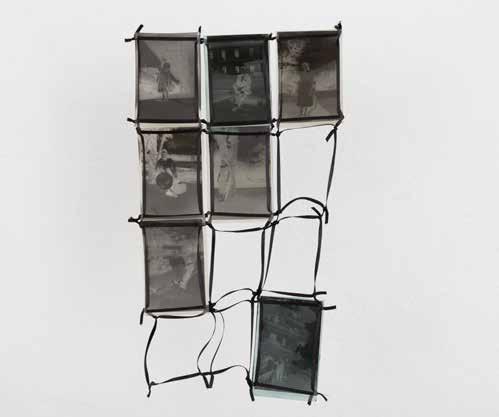
Vive e trabalha em Niterói. Bacharel em Cinema (UFF) e mestre em Comunicação e Cultura (UFRJ). Trabalha com colagem, desenho, pintura e fotografia. Aborda questões de identidade e gênero. Busca uma poética onde fantasiar e fetichizar o indivíduo são formas de se expor, e meios de acessar memórias de infância e reagir ao pré-estabelecido. Sua individual Amores Instantâneos esteve no CCJF, no Rio de Janeiro (RJ) em 2018. Em 2022, integrou os Salões de Guarulhos (SP), Vinhedo (SP) e Salão Ver-ão - Galeria Oásis (RJ).
Luiz Sisinno lives and works in Niterói. He has a bachelor in Cinema (UFF) and a master degree in Communication and Culture (UFRJ). He works with collage, drawing, painting, and photography. In his work, he addresses issues of identity and gender, seeking a poetics in which fantasizing and fetishizing the individual are ways of exposing oneself, as well as means of accessing childhood memories and reacting to the pre-established. His solo exhibition Amores Instantâneos (Instant Loves) took place at CCJF in Rio de Janeiro (RJ) in 2018. In 2022, he took part in the salon exhibitions of Guarulhos (SP), Vinhedo (SP) and Ver-ão - Galeria Oásis (RJ).
Mapô
A esteira é colocada para provocar uma abertura no ambiente da galeria e a expansão da mente do espectador enquanto o performer pratica uma pintura em Wají em seu corpo, que ativa a criatividade e explora a conexão ancestral com o elemento que constrói o poder. O atrativo da memória e a evidência da riqueza trazem de volta signos das matrizes africanas projetando uma figura que passeia entre os sacros Djinn das escrituras árabes, os Tuaregues do Mali e os Yaôs dos Candomblés do Brasil.
The mat is placed to provoke an opening in the gallery environment and the expansion of the spectator’s mind while the performer practices a Wají painting on his body, which activates creativity and explores the ancestral connection with the element that builds power. The attraction of memory and the evidence of richness bring back signs of the African matrix, projecting a figure that walks between the sacred Djinn of the Arab scriptures, the Tuareg of Mali and the Yaôs of the Candomblés of Brazil.

Mapô cresceu e vive no Morro da Boa Vista em Niterói (RJ). Pesquisa o teatro, a performance, a pintura, a arte digital e linguagens que evidenciam a poética da macumba brasileira: a fé nos orixás, nas entidades sagradas e as cosmopolíticas afro-ameríndias. Esteve no MAC-Niterói nas Exposições: Hu, a minha alegria atravessou o mar, com curadoria de Ana Bia Almeida; Suburbanidades, com curadoria de Cinthya Dias e; Quem é você Brasil?, com curadoria da Procult II e Por enquanto: Os primeiros 40 anos, no Centro de Artes UFF. Integrou a Mostra Miolo de Performances do Galpão Bela Maré e a Mostra MultiLinguagens da 5º Festival Transarte.
Mapô grew up and lives in Morro da Boa Vista, in Niterói (RJ). The artist researches theatre, performance, painting, digital art, and languages that highlight the poetics of Brazilian macumba: faith in orixás, sacred entities and Afro-Amerindian cosmopolitics. Mapô has presented work at MAC-Niterói, featuring in the group exhibitions Hu, a minha alegria atravessou o mar (Hu, my joy crossed the sea), curated by Ana Bia Almeida; Suburbanidades, curated by Cinthya Dias; Quem é você Brasil? (Who are you Brazil?), curated by Procult II; and Por enquanto: Os primeiros 40 anos (For now: The first 40 years), at the Centro de Artes UFF. The artist also took part in Mostra Miolo de Performances at Galpão Bela Maré and Mostra MultiLinguagens at the 5th Transarte Festival.
Marina Lattuca
Através da investigação de imagens arquetípicas formativas de sua individualidade, a artista esboça uma mitologia própria composta por arquétipos inventados, cada um batizado com um neologismo. A Magaril é uma derivação do termo em italiano magari, sem tradução exata para outras línguas, utilizado quando não se sabe ao certo se algo vai acontecer, mas que torce para que aconteça. A alegoria se materializa em uma veste religiosa, composta por um manto e adorno de cabeça feitos em cetim. O material, central na produção da artista, carrega ampla simbologia relacionada à religiosidade e festividades, que se fundem de modo surpreendente com a banalidade de uma matéria prima tão barata e artificial.
Nessa imagem arquetípica - que contém, invariavelmente, início, meio e fimimagens e palavras se fundem para uma anunciação

Through the investigation of archetypal images that form her individuality, the artist sketches her own mythology composed of invented archetypes, each one baptized with a neologism. A Magaril is a derivation of the Italian term magari, without an exact translation to other languages, used when one is not sure if something is going to happen, but is rooting for it to happen. The allegory is materialized in a religious garment, composed of a cloak and head adornment made of satin. The material, central to the artist’s production, carries ample symbology related to religiosity and festivities, which melt in a surprising way with the banality of such a cheap and artificial raw material. In this archetypal image - which invariably contains a beginning, middle, and endimages and words merge for an annunciation.
Veículos Para Ir Embora em Paz é uma série de dispositivos mitológicos e mágicos construídos para possibilitar deslocamentos impossíveis. O mitólogo Mircea Eliade afirmava que o homem “primitivo” ou “antigo” fechava-se em mitos como uma espécie escafandro, antes de mergulhar na realidade. Oito sapatos de pano atados uns aos outros trazem uma impossibilidade de movimento, ao mesmo tempo que indicam, dentro da linguagem do mito, que tempos assombrosos demandam ferramentas e soluções, à primeira vista, descabidas.
Veículos Para Ir Embora em Paz (Vehicles To Go Away in Peace) is a series of mythological and magical devices constructed to make impossible displacements possible. The mythologist Mircea Eliade stated that “primitive” or “ancient” man locked himself in myths like a kind of scuba diver before diving into reality. Eight cloth shoes tied together bring about an impossibility of movement, while at the same time indicating, within the language of myth, that haunting times demand tools and solutions that are, at first glance, unreasonable.
Marina Lattuca nasceu no Rio de Janeiro e constrói o próprio repertório a partir de símbolos associados ao tecido de cetim para costurar, desenhar e escrever novas mitologias. É formada em Jornalismo, foi aluna da EAV do Parque Lage e residente da Despina. Através da confecção de vestes, monstros, bandeiras e objetos, reivindica a necessidade de novas cosmogonias e a importância da linguagem mitológica como ferramenta primordial na transmissão de saberes. Participou do projeto Zona Aberta, no Museu de Arte Moderna do Rio e já realizou iniciativas de arte e educação em parceria com diferentes instituições e coletivos. A artista desenvolve o projeto literário de correspondências Correio-Monstro e, em 2021, foi selecionada para o Prêmio Off Flip de Literatura.
Marina Lattuca was born in Rio de Janeiro. She creates her own repertoire from symbols associated with satin fabric to sew, draw and write new mythologies. She has a degree in Journalism, was a student at EAV Parque Lage and a resident at Despina. Through the making of garments, monsters, flags and objects, she claims the need for new cosmogonies and the importance of mythological language as a primordial tool in the transmission of knowledge. She participated in the Zona Aberta project at the Museu de Arte Moderna do Rio de Janeiro and has collaborated on art and education initiatives in partnership with different institutions and collectives. The artist has an ongoing literary correspondence project called Correio-Monstro (Monster-Mail) and she was selected for the Off Flip Literature Award in 2021.

Mônica Coster
Teta trata das relações de alimentação e digestão travadas entre humanos e animais, dentro de um sistema de dominação e consumo. A instalação, feita de cerâmica, é composta por um duto vertical, fragmentado em quatro partes, que culmina em uma úbere bovina seccionada ao meio. Todas as peças são presas umas às outras e no teto com cabos de aço e anilhas, apresentando um corpo fragmentado, que não forma uma unidade coesa no espaço, composto apenas por esôfago e úbere. Um semianimal suspenso, como são as peças bovinas penduradas nos açougues. O trabalho parte de uma investigação sobre a figura conceitual do “gado”, grupo de animais criados em rebanho para fins alimentares, como agenciamento social, material e tecnológico que funciona como fonte e sustento para o sistema digestório humano.
Teta (Teat) deals with the relations of feeding and digestion between humans and animals, within a system of domination and consumption. The installation, made of ceramics, is composed of a vertical duct, fragmented in four parts, that culminates in a bovine udder sectioned in half. All the pieces are attached to each other and to the ceiling with steel cables and washers, presenting a fragmented body, which does not form a cohesive unit in space, composed only of esophagus and udder. A suspended semi-animal, like the bovine parts hung in butcher shops. The work starts from an investigation on the conceptual figure of “cattle”, a group of animals raised in herds for food, as a social, material, and technological agency that functions as a source and sustenance for the human digestive system.
Esôfago coloca em confronto a representação anatômica dos seres vivos e a materialidade do corpo animal presentificada no ovo da galinha. Sobre sua casca, o desenho do sistema digestório da ave aponta para a relação majoritariamente digestória que se estabelece entre humanos e animais e como estes, por sua vez, também se vinculam a outros seres dentro de uma cadeia alimentar. O trabalho se insere em uma investigação sobre a noção de “digestão expandida”, que considera a tessitura de relações de consumo e incorporação que envolvem o homem e a forma como influi sobre os seres que digere.
Esôfago (Esophagus) confronts the anatomical representation of living beings and the materiality of the animal body present in the chicken egg. On its shell, the drawing of the bird’s digestive system points to the mostly digestive relationship that is established between humans and animals and how these, in turn, are also linked to other beings within a food chain. The work is part of an investigation into the notion of “expanded digestion”, which considers the weaving of relations of consumption and incorporation that involve man and the way he influences the beings he digests.
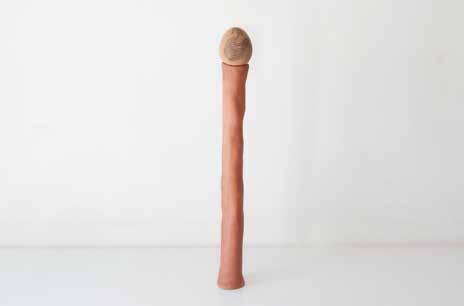
Mônica Coster vive no Rio de Janeiro. Em seu trabalho, investiga os processos de digestão e decomposição, explorando o interior digestivo humano como um sistema que se expande para outros seres e arranjos biossociais ligados à comida. Cerâmica, alimentos e materiais vivos são elementos recorrentes em suas esculturas e instalações. Mônica possui graduação em Artes Visuais pela UFRJ e mestrado em Artes pela UFF e participou de diversas exposições coletivas, entre elas: I Prêmio Vozes Agudas, Galeria Jaqueline Martins, São Paulo; Siete Performances, o nueve, Galeria Isabel Hurley, Málaga e Salão Arte Londrina 7.
Mônica Coster lives in Rio de Janeiro. In her work, she investigates the processes of digestion and decomposition, exploring the human digestive interior as a system that expands to other beings and biosocial arrangements linked to food. Ceramics, food and organic materials are recurring elements in her sculptures and installations. Mônica has a bachelor’s degree in Visual Arts from UFRJ and a master’s degree in Arts from UFF. She has participated in several group exhibitions, including: I Prêmio Vozes Agudas (First Acute Voices Award) at Galeria Jaqueline Martins, São Paulo; Siete Performances, o nueve (Seven Performances, or Nine), Isabel Hurley Gallery, Málaga; and Salão Arte Londrina 7.

Newton Santanna
Inspirada em uma fala de 2018 do então Presidente da República que comparava os negros à mercadorias que, depois usados por 388 anos de escravidão, foram descartados. Obra composta de empilhamento de caixas com rostos produzidos a partir da carbonização da madeira que remete aos rostos de negros na penumbra de um porão de um navio negreiro. Dispostos na superfície bidimensional do suporte, esses elementos criam volumes, ritmos e efeitos ópticos que perpassam pelos processos da pintura, da escultura e da gravura.
Inspired by a 2018 speech by the then President of the Republic, who compared black people to commodities discarded after being used as slaves for 388 years. The work is composed of stacking boxes with faces produced from the carbonization of wood that refer to the faces of black people in the penumbra of a slave ship’s hold. Arranged on the twodimensional surface of the support, these elements create volumes, rhythms, and optical effects that go through the processes of painting, sculpture, and engraving.

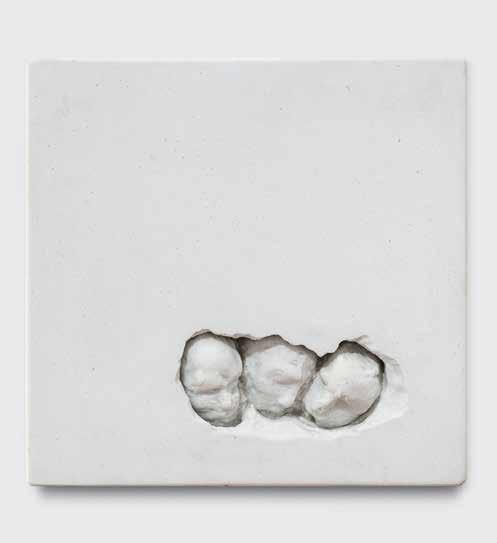
No trabalho de pesquisa dessa obra, exploro várias sensações de aprisionamento/sufocamento vivido nos anos da pandemia mundial, por conta do retrocesso das ideologias e pensamentos que deixaram suas marcas indeléveis em nossas vidas. Sensações que nos remetem às escotilhas dos navios negreiros, que lacravam tudo: não escapava ar, nem água, nem nada.
In the research process of this work, I explored various sensations of imprisonment/suffering experienced during the years of the world pandemic, because of the retreat of ideologies and thoughts that have left their indelible marks on our lives. Sensations that remind us of the slave ships’ hatches, which sealed everything shut: no air, no water, nothing could escape.
Escultor e professor de escultura figurativa, formado em engenharia, oriundo de Salvador (BA) onde permaneceu até 1995, ano em que iniciou seus estudos em arte. Em 2000, mudou-se para a capital de São Paulo para estudar e ser assistente do escultor Israel Kislansky, em cujo atelier lecionou e desenvolveu vários projetos até 2006. Estuda desenho e pintura com Philip Hallewell e Luiz Alberto Genaro e aquarela com Gonzalo Carcamo. Em 2006, montou seu ateliê, onde trabalha até hoje.
Newton Santanna is a sculptor and professor of figurative sculpture. He was born in Salvador (BA) where he lived until 1995, the year he began his art studies. He graduated in engineering. In 2000 he moved to São Paulo to study and work as an assistant of the sculptor Israel Kislansky, in whose studio he taught and developed several projects until 2006. He studied drawing and painting with Philip Hallewell and Luiz Alberto Genaro, and watercolour with Gonzalo Carcamo. In 2006 he set up his own studio, where he still works to this day.
Rafael Vilarouca
A animação de fotografias de pinturas-murais de paisagem feitas em bares, motéis e espaços públicos na capital Fortaleza, Icó e Juazeiro do Norte, duas últimas cidades no interior do Ceará, representadas na geografia do Estado como uma linha que cruza a região de Norte a Sul, exprime uma possibilidade de reutilização dessas imagens como metalinguagem das paisagens visualizadas nesses deslocamentos: uma tentativa de aproximar e evidenciar contradições entre natureza e cidade, imagem e ruína, artifício e realidade. No movimento de imagens adentrando entre si, um panorama cartográfico aglutina a paisagem ao mesmo tempo que a ficcionaliza.
The animation of photographs of landscape mural paintings made in bars, motels and public spaces in the capital city Fortaleza, as well as in Icó and Juazeiro do Norte, interior of Ceará, are represented in the geography of the state as a line that crosses the region from North to South, expressing a possibility of reusing these images as a metalanguage of the landscapes visualized in these displacements: an attempt to approximate and highlight contradictions between nature and city, image and ruin, artifice and reality. In the movement of images entering each other, a cartographic panorama agglutinates the landscape at the same time that it fictionalizes it.

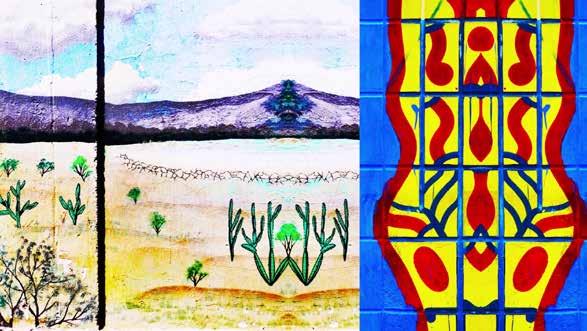
A paisagem urbana constitui-se de forma similar às paisagens naturais. A cidade participa da própria forma perspectivista e sinestésica que produz a paisagem. A simulação de espaços, nesse sentido, permite reinventar, parte por parte, uma natureza condensada e artificial, sensível às dimensões do tempo: imagem que acumula, dá e retira a realidade ou o tempo que converge.
The urban landscape is constituted in a similar way to natural landscapes. The city participates in the very perspectivist and synesthetic form in which it produces the landscape. The simulation of spaces, in this sense, allows one to reinvent, part by part, a condensed and artificial nature, sensitive to the dimensions of time: an image that accumulates, gives and takes away the realities or times that it converges.
Licenciado em Artes Visuais pela Universidade Regional do Cariri – URCA (CE), possui também bacharelado em Direito pela mesma instituição, sendo atualmente mestrando em Linguagens Visuais pela Escola de Belas Artes - UFRJ. Em 2016, foi aluno residente no Laboratório de Criação do Porto Iracema das Artes em Fortaleza e, em 2021, participou da residência O álbum é a Obra proposto pelo IFoto, tendo sido premiado em 2015 no 66º Salão de Abril, em Fortaleza (CE).
Rafael Vilarouca obtained a licentiate degree in Visual Arts from the Regional University of Cariri – URCA (CE), and holds a bachelor degree in Law from the same institution. He is currently a master student at the Visual Languages programme of the Escola de Belas Artes - UFRJ. In 2016 he was a resident student at the Porto Iracema das Artes Creation Laboratory in Fortaleza, and in 2021 he took part in the residency programme O álbum é a Obra (The Album is the Work), proposed by IFoto. He was awarded at the 66th Salão de Abril in Fortaleza (CE) in 2015.
Raphael Medeiros
Rebatedor, 2022 / Pelo interesse do artista no extracampo do plano cinematográfico, a maquinaria de bastidor assume o protagonismo neste trabalho. A lona rebatedora, que serve de suporte para essa pintura, é um equipamento cotidiano em filmagens. O processo de pintura através da pigmentação por fumaça imprime uma coloração disforme e traz marcas difusas da memória.
Because of the artist’s interest in the expanded field of the cinematographic plane, the backstage machinery takes center stage in this work. The reflector board, which serves as a support for this painting, is an everyday piece of equipment in filming. The process of painting through smoke pigmentation imprints a shapeless coloration and shows diffuse marks of memory.
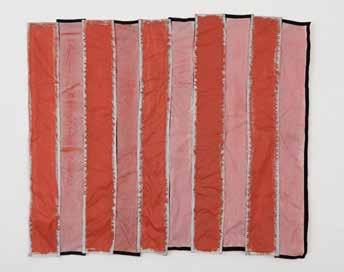
Balão de Mil, 2022 / O balão e os sinalizadores de fumaça são objetos presentes na prática do cinema. E essa obra remonta o encanto das produções cinematográficas, como um filme exposto de alusões dissipadas. Memória e ficção se misturam num jogo de sombra, luz e cor. O atrito com a finalidade usual do objeto balão possibilita encontros que acontecem fora do visor
da câmera, trazendo à cena diálogos que tentam escapar.
The balloon and smoke signals are objects present in the practice of cinema. This work recalls the charm of cinematographic productions, like an exposed film of dissipated allusions. Memory and fiction mix in a game of shadow, light and color. Friction with the usual purpose of the balloon object enables encounters that take place outside the camera’s viewfinder, bringing to the scene dialogues that try to escape.
sem título 04, 2023 / Nessa obra, a lona difusora assume protagonismo. A materialidade de repertório pessoal projetada nesse objeto de bastidor conversa com o que está além da moldura da câmera. Subjetivamente acompanhamos a dissipação de imagens oníricas, memórias e a própria linguagem cinematográfica.
In this work, the diffuser canvas assumes protagonism. The materiality of a personal repertoire projected onto this backstage object converses with what lies beyond the camera frame. Subjectively, we follow the dissipation of dreamlike images, memories and cinematographic language itself.


“Dissipação” é o nome de minha pesquisa. Nela experimento a linguagem cinematográfica para além da moldura do plano, deslocando os elementos físicos do cinema (refletores, tubos, maquinaria, lonas) para utilizá-los em outras poéticas visuais, como pintura e instalação. Este contexto serve de suporte para imergir no íntimo de uma série de memórias que dissiparam meu núcleo familiar. Entre 2016 e 2022 apresentei “Cavalo” na Galeria 5 Bocas. Meu filme “Cadeia Alimentar” foi licenciado pelo Canal Brasil e vencedor do SPFF - São Paulo Film Festival. Dirigi os filmes de campanha de Marielle Franco e fui professor de linguagem cinematográfica na Escola de Cinema Darcy Ribeiro.
‘Dissipação’ (Dissipation) is the name of my research, in which I experiment with cinematic language beyond the frame of the shot, displacing the physical elements of cinema (reflectors, tubes, machinery, canvas) to use them in other visual poetics, such as painting and installation. This context serves as a medium to immerse myself in the depths of a series of memories that dissipated my family nucleus. Between 2016 and 2022 the following activities took place: I presented ‘Cavalo’ (Horse) at Galeria 5 Bocas; my film ‘Cadeia Alimentar’ (Food Chain) was licensed by Canal Brasil and awarded at the São Paulo Film Festival (SPFF); I also directed Marielle Franco’s campaign films, and taught a course in cinematographic language at the Escola de Cinema Darcy Ribeiro.
Rebeca Miguel
A obra em questão faz parte da série de pinturas Mãos que (des)cansam, que evoca a relação existente entre o ócio e o cansaço trazendo essa parte do corpo que é fazedora de coisas. Por meio da transparência, do escorrido e da mancha, Rebeca Miguel coloca em fragmentos os espaços de tempo em que o descanso de pessoas como Ponciá - de Conceição Evaristo - possa existir. A pintura existe em sua materialidade enquanto uma continuidade do tempo-espaço em que o descanso se coloca como pequenos fragmentos do presente.
The work in question is part of the series of paintings Mãos que (des)cansam (Rested/ Tired Hands), which evokes the relationship between idleness and tiredness, especially highlighting this part of the body that makes things. Through transparency, dripping, and staining, Rebeca Miguel puts into fragments the spaces of time in which the rest of people like Ponciá - by Conceição Evaristo - can exist. The painting exists in its materiality as a continuity of a timespace in which rest is understood as a small fragment of the present.
Por meio da pintura O (des)canso de Ana, Rebeca Miguel traz o ócio enquanto ato de resistência. A artista usa da linguagem pictórica para questionar as estruturas sociais nas quais mulheres negras não têm direito ao descanso. Ao retratar mulheres do atual convívio - como Ana - em momentos de descanso, ela traz um ócio desprovido de inércia, que se faz presente também pelas manchas na parte superior da pintura. A transparência e o inacabado aparecem como elementos que trazem uma dualidade provocada pelos atravessamentos de toda uma vivência.
Through the painting O (des)canso de Ana (Ana’s Rest/Tiredness), Rebeca Miguel suggests idleness as an act of resistance. The artist uses her pictorial language to question the social structures in which black women have no right to rest. By depicting women currently in her life - like Ana - in these rare moments, she highlights an idleness devoid of inertia, which is also made present by the stains on the upper part of the painting. Transparency and an unfinished aspect to her work appear as elements that propose a duality provoked by the crossings of an entire experience.
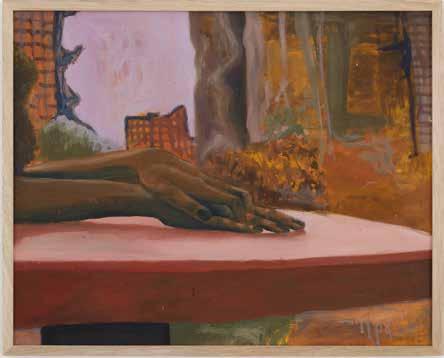
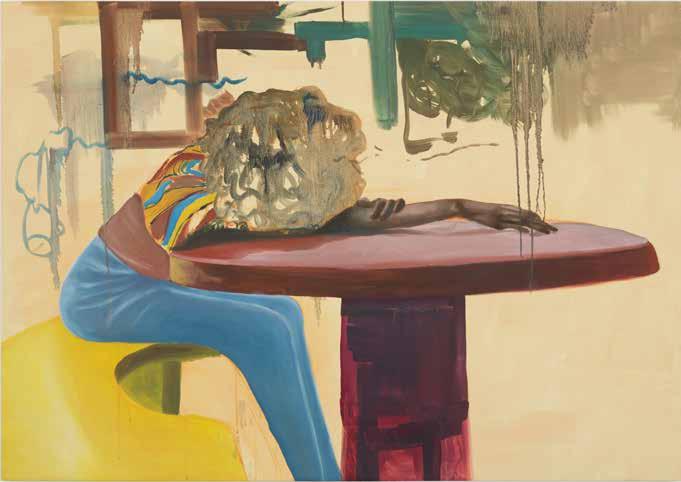
Rebeca Miguel nasceu em Belo Horizonte, onde vive e trabalha. Por meio da linguagem pictórica, (re)visita suas memórias de infância numa tentativa de reconstrução do passado e coloca o ócio enquanto ato de resistência. Em 2022, abre a individual Me canso no (des)canso dela, na Galeria Godarc, mesmo ano em que participou do 50° Salão de Arte Contemporânea Luiz Sacilotto, em São Paulo e integrou as coletivas De corpo e tinta, no Espaço Arteducação da FaE/UFMG e Quintais, na Galeria Quartoamado.
Rebeca Miguel was born in Belo Horizonte, where she lives and works. Through pictorial language, she (re)visits her childhood memories in an attempt to reconstruct the past, and proposes idleness as an act of resistance. In 2022 she presented her solo exhibition Me canso no (des)canso dela (I get tired from her rest) at Galeria Godarc, the same year in which she took part in the 50th Luiz Sacilotto Contemporary Art Salon in São Paulo, and the collective exhibitions De corpo e tinta (Of Body and Paint) at the Espaço Arteducação of FaE/UFMG, and Quintais (Backyards) at Galeria Quartoamado.
Rose Afefé
Fragmentos de Memória é um trabalho que perpassa lembranças da infância da artista, a casa onde cresceu e o material construtivo utilizado. É também um movimento de ressignificação da origem, pois para muitas pessoas a casa de adobe (tijolo de barro cru) era um símbolo de pobreza. Orientada pelo fazer intuitivo, Rose constrói pequenas paredes a fim de relembrar e reconstruir o espaço que acolheu sua infância e adolescência ressaltando a necessidade de reconhecer e transformar um sentimento de indiferença para com a sua história, fruto de uma sistemática colonial que define o que tem ou não tem valor.
Fragmentos de Memória (Fragments of Memory) is a work that permeates memories of the artist’s childhood, the house where she grew up and the construction material used. It moves to reframe her origins, as for many people the adobe house (raw clay brick) was a symbol of poverty. Guided by intuitive making, Rose builds small walls in order to remember and rebuild the space that sheltered her childhood and adolescence, emphasizing the need to recognize and transform a feeling of indifference towards her history - result of a colonial system that defines what has or has no value.
Fragmentos de Memória [Fragments of Memory], 2023 / instalação | tijolos de barro cru e cal [installation | raw clay bricks and lime] / dimensões variáveis [variable dimensions]
Rose Afefé é artista (Varzedo, Bahia, 1988). Em 2018, começou a desenvolver o projeto Terra Afefé, resgatando memórias da sua infância no interior da Bahia. A obra trata da construção de uma microcidade que propõe vivências e imersões artísticas. Foi indicada ao Prêmio Pipa 2022 e premiada no Salão de Artes Visuais da Bahia, em 2012. Participou das coletivas: 32º Mostra CCSP, Horizonte de Eventos no Largo das Artes (RJ), Zil,zil,zil no Centro Municipal de Artes Hélio Oiticica (RJ), VIII e XII Bienal do Recôncavo (BA) e Esquizópolis no MAM-BA. Também participou da residência artística Muros: Territórios compartilhados, em Fortaleza (CE).
Rose Afefé (Varzedo, Bahia, 1988) is an artist. She began to develop the Terra Afefé project in 2018, recovering her childhood memories of the Bahia countryside. Her work deals with the construction of a microcity that proposes experiences and artistic immersions. She was nominated for the 2022 Pipa Prize and awarded at the 2012 Salão de Artes Visuais of Bahia. She participated in the following group exhibitions: 32nd Mostra CCSP; Horizonte de Eventos (Horizon of Events) at Largo das Artes (RJ); Zil, zil, zil at the Centro Municipal de Artes Hélio Oiticica (RJ); the 8th and 9th editions of the Bienal do Recôncavo (BA); and Schizopolis at MAM-BA. She also participated in the artistic residency programme Muros: Territórios compartilhados (Walls: shared territories) in Fortaleza (CE).
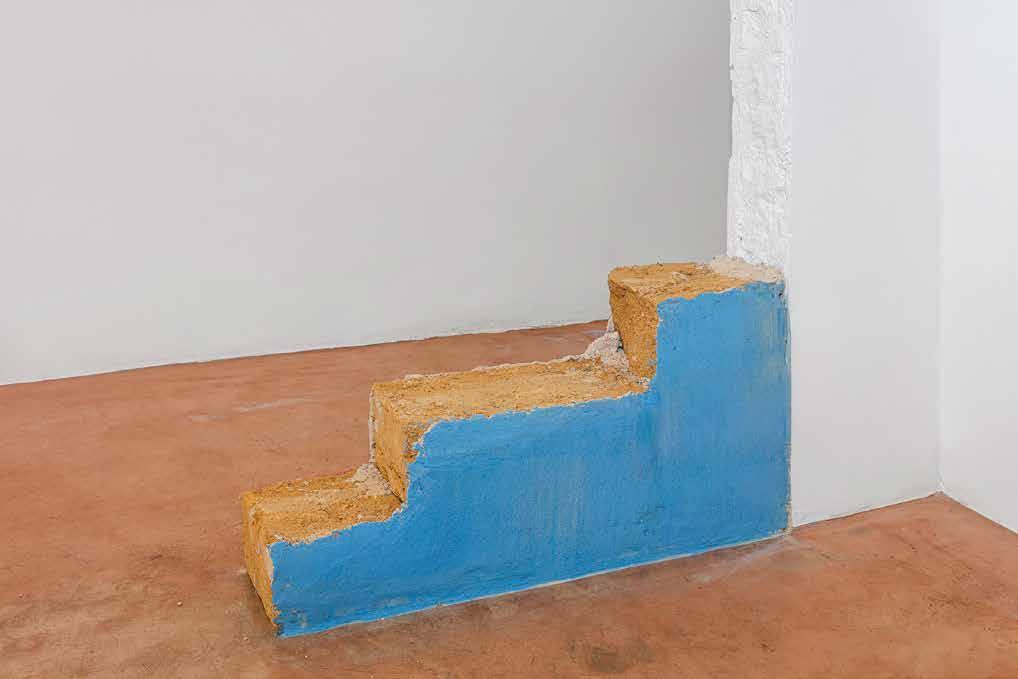
Vulcanica Pokaropa
Poder y Glória [Power and Glory], 2022 / fotografia analógica, impressão fine art [analogic photograph, fine art print] / 44 x 52 cm [17 3/8 x 20 1/2 in] / 6 edições + 2 P.A. [Edition of 6 plus 2 artist’s proofs]
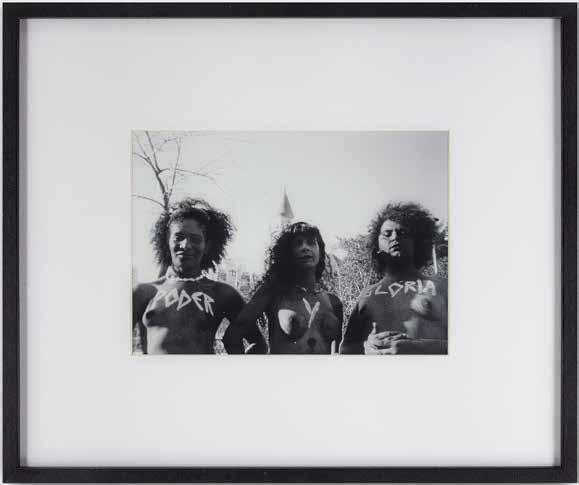
Poder y Glória é uma releitura da obra Poder (1972) , de Carlos Vergara, onde trago três travestis pretas com os escritos no peito e a igreja de fundo, pensando na retomada dessas palavras para nós, já que o cistema tenta desassociar a todo momento ambas as coisas de nossas imagens e vidas. A palavra poder me leva para vários caminhos, tanto o poder aquisitivo que é necessário para que possamos viver com dignidade, quanto o poder ligado à autonomia, escolha, pensamentos, dentre outras coisas. Trago a Glória para que não esqueçamos que ter fé também é um direito nosso, seja ela representada e entendida da forma que cada pessoa escolher.
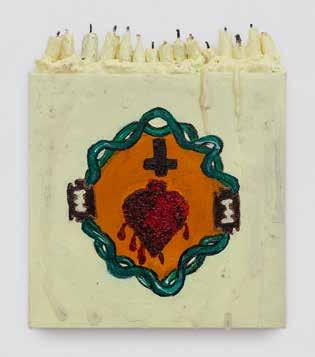

Poder y Glória (Power and Glory) is a new take on the work Poder (1972), by Carlos Vergara, where I bring three black transvestites with writing on their chests and the church in the background, thinking about the resumption of these words for us, since the system tries to disassociate at all times both things from our images and lives. The word power takes me to several paths, both the purchasing power that is necessary for us to live with dignity, and the power linked to autonomy, choice, thoughts, among other things. I bring Glory so that we don’t forget that having faith is also our right, no matter how it is represented and understood.
Ressurreição e Imaculado integram a série Intercessão, que faz parte da pesquisa em arte católica que venho fazendo. Vivi desde que nasci até os 15 anos de idade dentro da religião/igreja católica e tenho trazido símbolos e imagens desse contexto ressignificando-os para algo que inclua mais pessoas como eu. Não para nos santificar, mas para borrar as fronteiras entre limpo vs. sujo, profano vs. sagrado etc.
Ressurreição (Resurrection) and Imaculado (Immaculate) are part of the Intercessão (Intercession) series, which emerges from my ongoing research on Catholic art. From the moment I was born until I was 15 years old, I lived inside the Catholic religion/church, and I have been revisiting symbols and images from that context, re-signifying them into something that includes more people like me. Not to sanctify us, but to blur the boundaries between clean vs. dirty, profane vs. sacred, etc.
Vulcanica Pokaropa é Travesti formada em Fotografia, Mestra em Teatro pela Udesc, Doutoranda em Artes pela Unesp. Sua pesquisa aborda a presença de pessoas Trans, Travestis e Não Bináries no Teatro, Performance e Circo. Integra a Cia Fundo Mundo de Circo, formada exclusivamente por pessoas Trans. Performer, produtora cultural, artista plástica e visual. Produtora da série Desaquenda, que faz parte do acervo do MAM São Paulo, do MAC Paraná e está disponível no YouTube no canal Cucetas Produções.
Vulcanica Pokaropa is a travesti artist who graduated in Photography, has a master’s degree in Theatre from Udesc, and is currently undertaking a PhD in Arts from Unesp. The artist’s research addresses the presence of Trans, Travesti and Non-Binary people in Theatre, Performance and the Circus. Vulcanica is a member of the Fundo Mundo de Circo company, made up exclusively of Trans people. Vulcanica is a performer, cultural producer, and visual artist, who also produced the Desaquenda series, which is part of the collections of MAM-SP and MAC-Paraná, and is available for viewing on YouTube on the Cucetas Produções channel.
Yanaki Herrera
Em territórios que foram colonizados e catequizados, rege um ideal social sobre uma maternidade exemplar, o qual diz respeito à imagem e simbologia de Maria, mãe de Jesus. Maria foi uma mulher que não teve o direito a escolha sobre o próprio corpo e foi apenas avisada da concepção. Quais são esses valores que determinam quem é uma boa mãe e como se deve comportar uma boa mãe? A quais desejos renunciamos? Quais são as maiores saudades que carrego desde que me tornei mãe? E o gozo e sexualidade? Este corpo marrom grávido que mostra um peito nu e deixa cair no seu ombro um tecido de lã dos andes rodeada de raios, fala sobre o resgate da sua sexualidade e do encontro consigo para além do papel de mãe.
In territories that were colonized and catechized, a social ideal of exemplary maternity rules. It concerns the image and symbolism of Mary, the mother of Jesus. Mary was a woman who had no right to choose over her own body and was only told about her conception. What are these values that determine who is a good mother and how a good mother should behave? What desires do we renounce? What are the things I miss the most from before becoming a mother? What about enjoyment and sexuality? This brown pregnant body that shows a naked breast and allows an Andean woolen cloth to drop from her shoulder is surrounded by the sun’s rays. It talks about the recovery of her sexuality and an encounter with herself beyond the role of a mother.
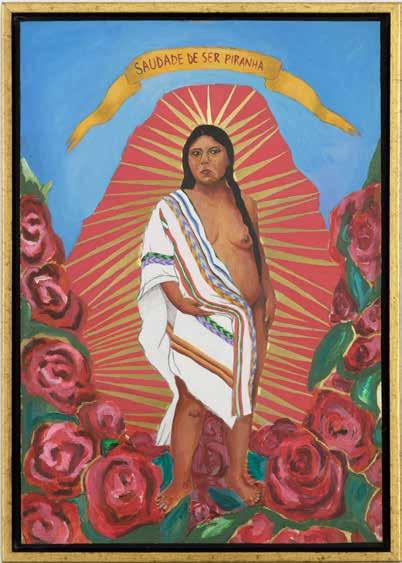
A criança mascarada que é o futuro carrega uma cerâmica Moche (100 a.C. e 800 d.C.). Ela anda em meio de uma paisagem que é a mistura entre as montanhas da serra peruana e, no solo verde, as bananeiras do Brasil. O filho onça é filho do ancestral, do vivo e das poeiras, da flora e da fauna, do brincar, do aprender e ensinar, filho da terra, das águas fartas, do milho e da batata. Esta pintura da criança que nasce no Brasil e que é filho de mãe peruana, traz em questão quais são as fronteiras que separam esses territórios:o humano do animal? A morte da vida? O passado e o presente? O esquecimento e a retomada? Afinal, o futuro é ancestral.
The masked child who is the future carries a Moche pottery (100 BC and 800 AD). She walks in the middle of a landscape that is a mixture between the mountains of the Peruvian highlands and, on the green soil, the banana trees of Brazil. The jaguar child is the child of the ancestor, of the living and the dust, of the flora and fauna, of playing, learning and teaching, the child of the earth, of the abundant waters, of the corn and the potato. This painting of a child born in Brazil to a Peruvian mother brings into question the boundaries that separate these territories: the human from the animal? Death from life? The past and the present? Forgetting and remembering? After all, the future is ancestral.
Yanaki Herrera é nascida em Cusco, Peru e atualmente vive em Belo Horizonte. Sua pesquisa artística é voltada para a maternagem e as suas lutas. Através da pintura, trabalha com narrativas que conversam entre a ancestralidade e o presente evidenciando as sequelas da colonialidade. Compõem a sua imagética elementos característicos da América Latina que nascem a partir da cumbia, da migração e das culturas populares.
Yanaki Herrera was born in Cusco, Peru and currently lives in Belo Horizonte. Her artistic research is focused on motherhood and its struggles. Through painting, she works with narratives that move between ancestry and the present, highlighting the consequences of coloniality. Her imagery is composed of characteristic elements from Latin America that stem from cumbia, migration and popular cultures.
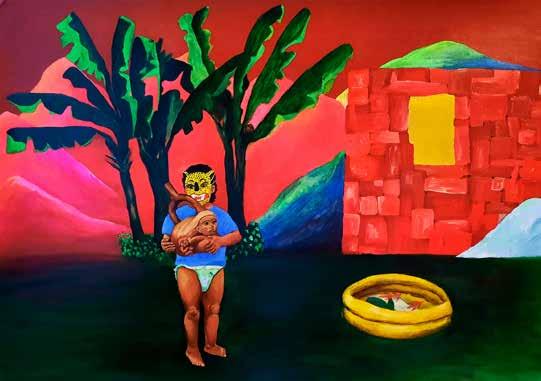
falatório misto sobre papel gente do céu, gente do inferno, limbou o cavalinho, abrem-se os buracos nas pedras mas não vejo mais, não lembro mais como se lê, o inferno a gente não vai ver mais e o céu já tá lotado também, eita como invade. a mesa fluxiana no teto, a menina cavando de colher, o suor acumulado e poxa, vocês tavam lá? achei pesado, gostei. tava muito envolvida, é muito céu e vamos do inferno ao céu em uma fração de segundos. tá me dando taquicardia. o público uniformizado, olha a paleta! essas coisas que acendem elas ficam acesas? eita como é ateu! está se autobobificando, ele deve ser jovem né, esse não tem tempo de ir praquele bar, tá trabalhando muito, pelo menos parece que sabe trabalhar, é um gatinho, vamos parir mais um? que mãe massa, já você é a mão do inferno, exposição bonita, mas você não me segue, eita como performa seu olho de vidro na mão abençoada do inferno, meu público alvo são os ratos que comem seus pantenes de queijo, eita como teorizam, destruição tem que ir para algum lugar, pro inferno, pode ser inferno. se eu vi, a galera vai ter que ver também. bem ali, do lado da pintura soviética, ela ta chamando pra mão com suas técnicas místicas e pode mexer sim, só comprar! olha a teta, demais! é do meu casting, eu gostei, já fiz. do limbo tá mais próximo do inferno, né? eita como cartografa, mas ele tá bem, pode ficar numa boa no inferno, fazendo cosplay de brega, são novos infernos, os infernos de agora. eu gostei, vou fazer, gostei do piu-piu também, eles colocam esses nomes, se rebatizam, muito gatinho, mas acho que não, então segue para o inferno, vai conversar com o fascista lá, nem vai poder ir pro bar descolado. cabeças vão rolar, afie sua faca, estamos em um mata mata no céu e daqui a pouco já tô pegando o avião pro pavilhão de goiânia, a gente tá no céu, um artista azul! uma performance azul! eu vou me auto calar, me comunicar por partituras em relevo, o objeto performa, que coisa. dá vontade de olhar pra ele, tem criança que faz isso, finge que não existe.
o Abre Alas é uma porta de entrada para alucinações mais pesadas. depois de fumar eu te devolvo as cinzas.
Por Julia Pellegatti Frejat
mixed chattering over paper people from heaven, people from hell, limboed the little horsey, holes in the rocks open up but I can’t see anymore, I don’t remember how to read, we won’t be seeing hell no more and heaven is crowded too, look how it invades. the fluxian table on the ceiling, the girl digging with a spoon, the accumulated sweat and oh boy, you guys were there? I thought it was heavy, I liked it. I was really involved, it’s a lot of heaven and we go from hell to heaven in a fraction of seconds. It’s making my heart race. the audience in uniform, check out the palette! these things that light up, do they stay lit? wow, how atheist! he’s self-fooling, he must be young, right, doesn’t have time to go to that bar, is working too much, at least it seems like he knows how to work, he’s cute, let’s give birth to one more? what a cool mom, you on the other hand are the hand of hell, nice exhibition, but you don’t follow me, wow, how they perform their glass eye into the blessed hand of hell, my target audience are the rats that eat your cheese shampoos, geez, how they theorize, destruction has to go somewhere, to hell, it could be hell. if I saw it, the guys will have to see it too. right there, next to the soviet painting, she’s calling the hand with his mystical techniques and you can touch it, sure, just buy it! look at the tit, awesome! it’s my casting, i liked it, already did it. limbo is closer to hell, right? wow, does he map it out, but he’s alright, can chill in hell, doing tacky cosplaying, these are new hells, the hells of now. I liked it, gonna do it, I like the birdie too, they give these names, rebaptize themselves, such a cutie, but I don’t think so, so go on to hell, go talk to the fascist there, you won’t even be able to go to the hip bar. heads will roll, sharpen your knife, we’re in the knockout round in heaven and soon I’ll be catching the plane to the goiânia pavilion, we’re in heaven, a blue artist! a blue performance! I’m going to silence myself, will communicate only through high relief score sheets, the object performs, what a thing. makes you wanna look at him, some children do that, pretend that it doesn’t exist. Abre Alas is a gateway to heavier hallucinations. after smoking I’ll give you back the ashes.
By Julia Pellegatti FrejatPublicado pela A Gentil Carioca por ocasião da exposição Abre Alas 18, realizada em São Paulo entre 09/02/2023 e 11/03/2023, e no Rio de Janeiro entre 11/02/2023 e 15/04/2023, nas sedes da galeria A Gentil Carioca, com curadoria de Bruna Costa, Lia Letícia e Vivian Caccuri.
Published by A Gentil Carioca on the occasion of the exhibition Abre Alas 18, from 02/09/2023 to 03/11/2023 in São Paulo, and from 02/11/2023 to 04/15/2023 in Rio de Janeiro, at the A Gentil Carioca spaces, curated by Bruna Costa, Lia Letícia and Vivian Caccuri.

A GENTIL CARIOCA
Sócios (Partners)
Ernesto Neto, Laura Lima, Márcio Botner e Elsa Ravazzolo Botner
Direção (Directors)
Elsa Ravazzolo Botner e Márcio Botner
Administrador financeiro (Administration and finance department)
Alberto Evaristo Bernabé
Coordenadora de produção (Production coordinator)
Rosa Melo
Produção e logística (Production and logistics)
Anna Pitthan
Elodie Salmeron
Érika Nascimento
Giulia Ferrão
Liah Ribeiro
Estagiária de produção (Production trainee)
Júlia Frejat
Vendas (Sales)
Ton Martins
Beatriz Coslovsky
Conteúdo (Content)
Luma Lorenzon
Coordenação de design (Design coordinator)
Liliane Kemper
Design
Theo Cunha
Arquivo (Archive)
Beatriz Coslovsky
Montagem e acervo (Installation and collection)
Victor Lorenzetto e Fagner França
Manutenção (Maintenance)
Victor Hugo Santiago
Assistente de administração e finanças (Administrative and financial assistant)
Vinícius Amorim Tavares
Analista administrativo financeiro (Financial administrative analyst)
Bárbara Cunha Dantas Dória
Estagiária da área financeira (Financial trainee)
Marcella de Vasconcelos Souza
Serviços gerais (General services)
Zezé (Maria José Venâncio Sales)
ABRE ALAS 18
EVENTO DE ABERTURA (OPENING EVENT)
São Paulo
DJ Aya Ibeji
Bateria do Grêmio Recreativo Cultural e Social Escola de Samba Vai-Vai
Rio de Janeiro
DJ Galo Preto
DJ Tata Ogan
Reviravolta de Gaia do Coletivo #florestadecristal
Bateria Balança Mas Não Cai
CATÁLOGO (CATALOGUE)
Edição e design gráfico (Editing and graphic design)
Liliane Kemper
Tradução (Translation)
Tanja Baudoin
Revisão (Proofreading)
Thais Medeiros
Fotos (Photos)
Filipe Berndt - p.16 (Antipostais de Minas Gerais), p.21 (Ao fundo, o plano), p.22, p.23, p.24, p.27 (Raízes que batem no céu (1)), p.36, p.37
Gualter dos Santos - p. 5
Maria Baigur - p.4
Pedro Agilson - p.10 (Fogo), p.11, p.12, p.13, p.14, p.15, p.17 (Poemas Financeiros), p.18 (Arquivo Morto), p.19, p.20, p.21 (Verde Levante), p.26 (Sonhe Alto Trabalhe Muito - Vá Longe #6), p.27 (Raízes que batem no céu (2)), p.28, p.30 (Veículo para ir Embora em Paz n3), p.34, p.35, p.38 (Desejos e saudades para além da maternagem)
